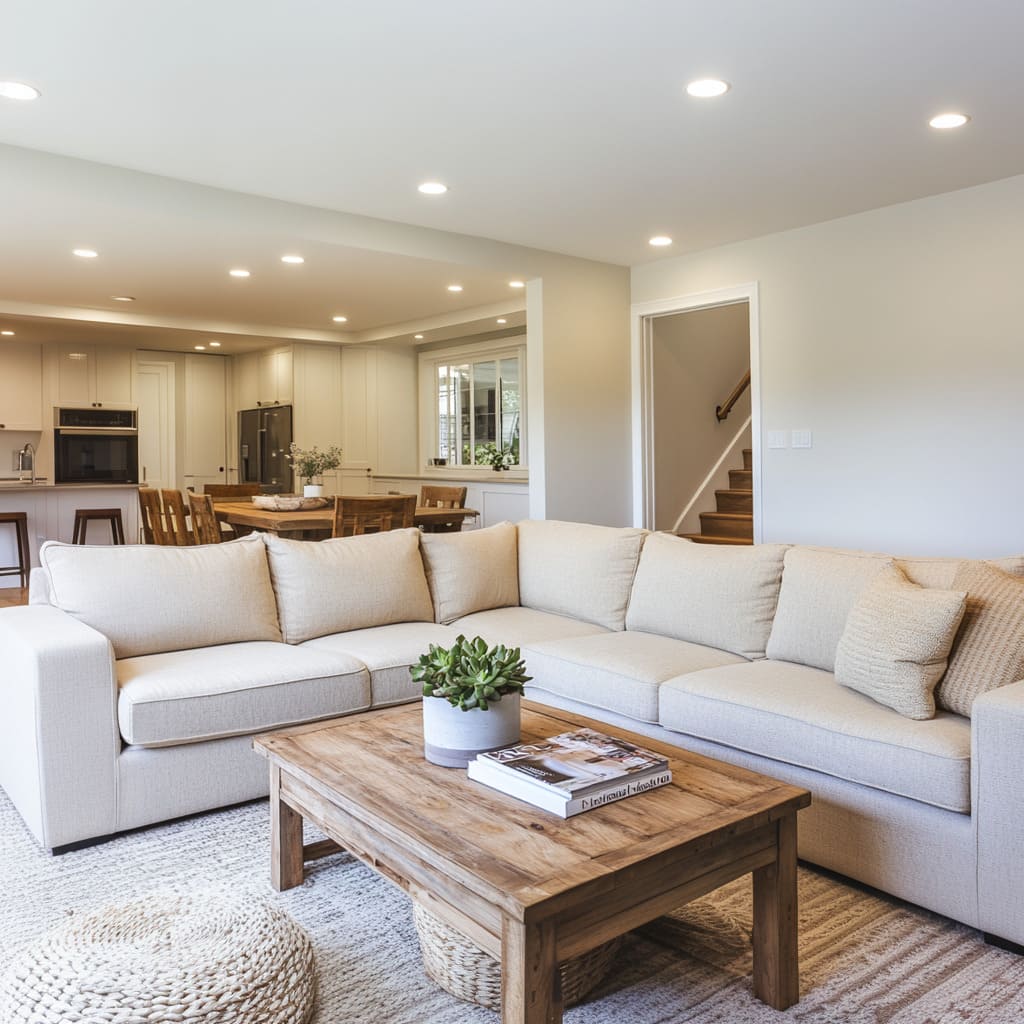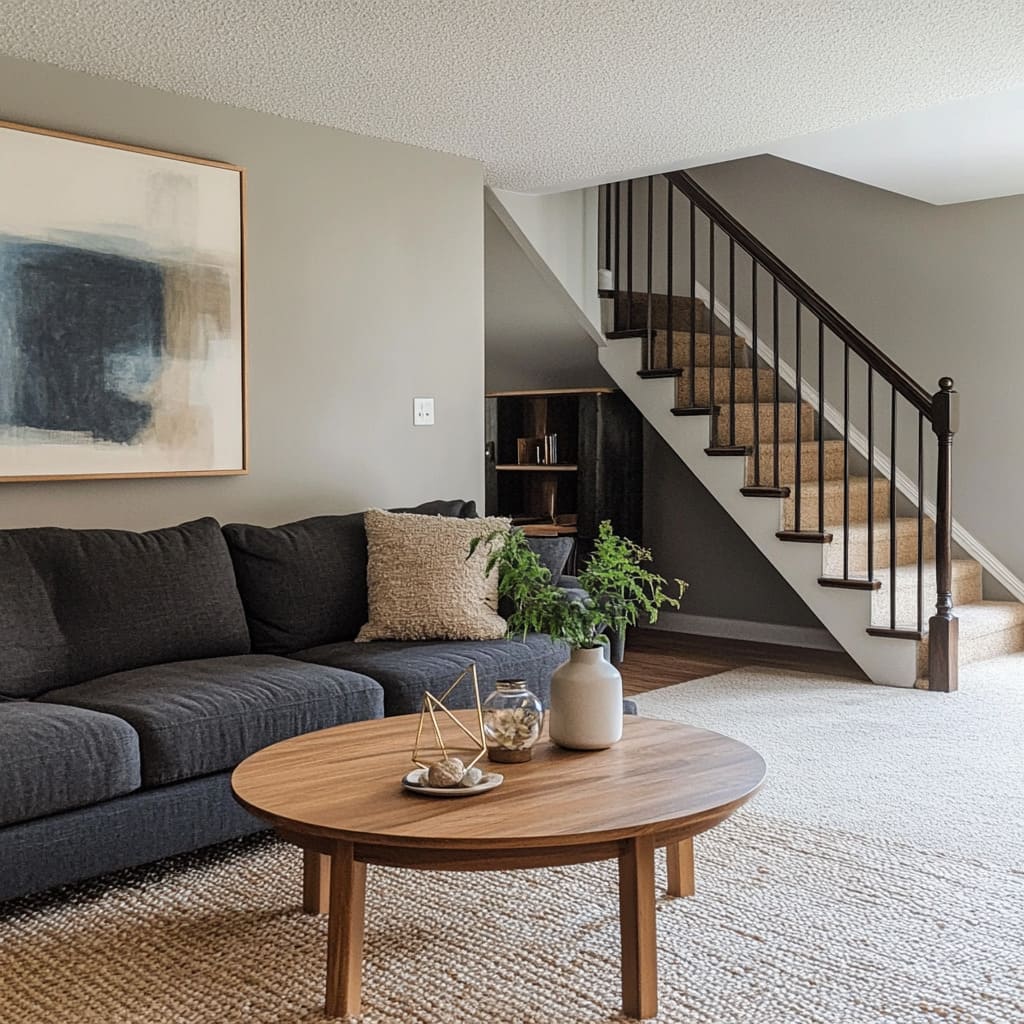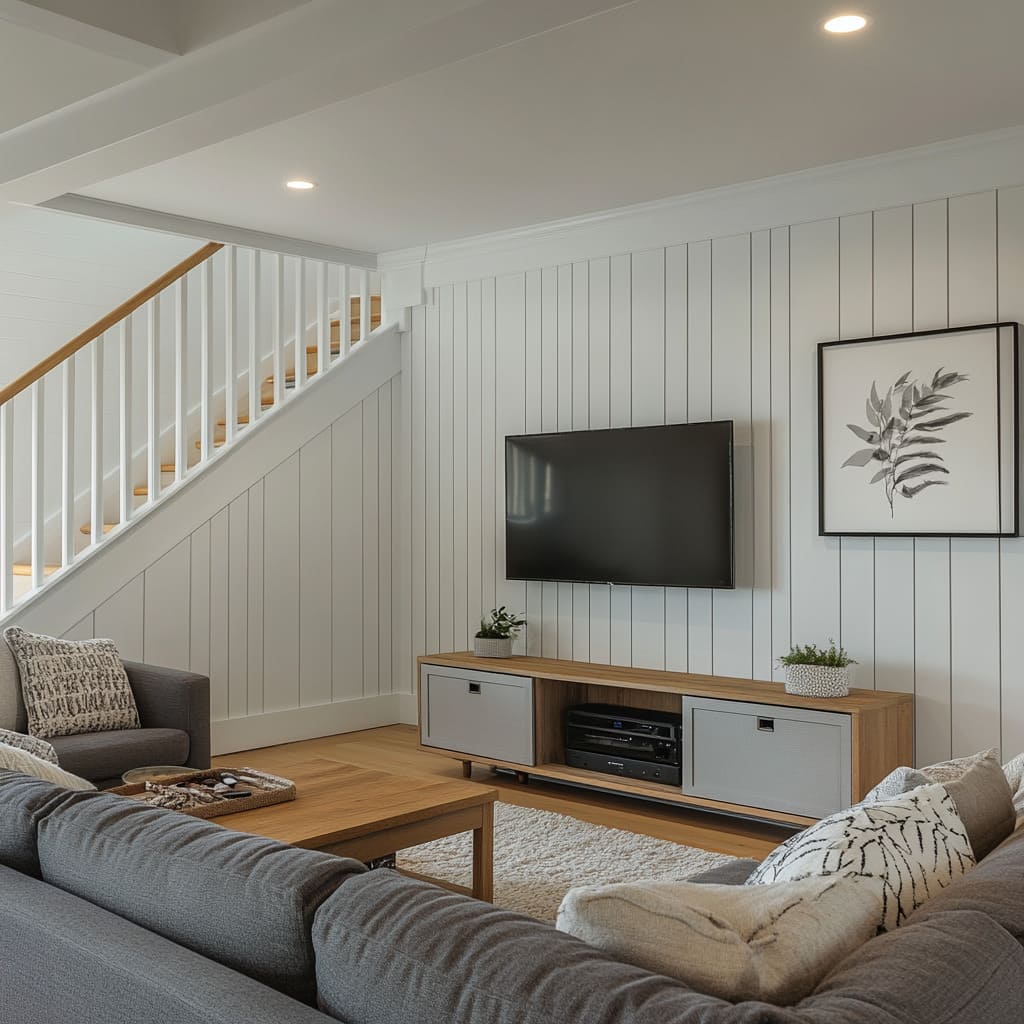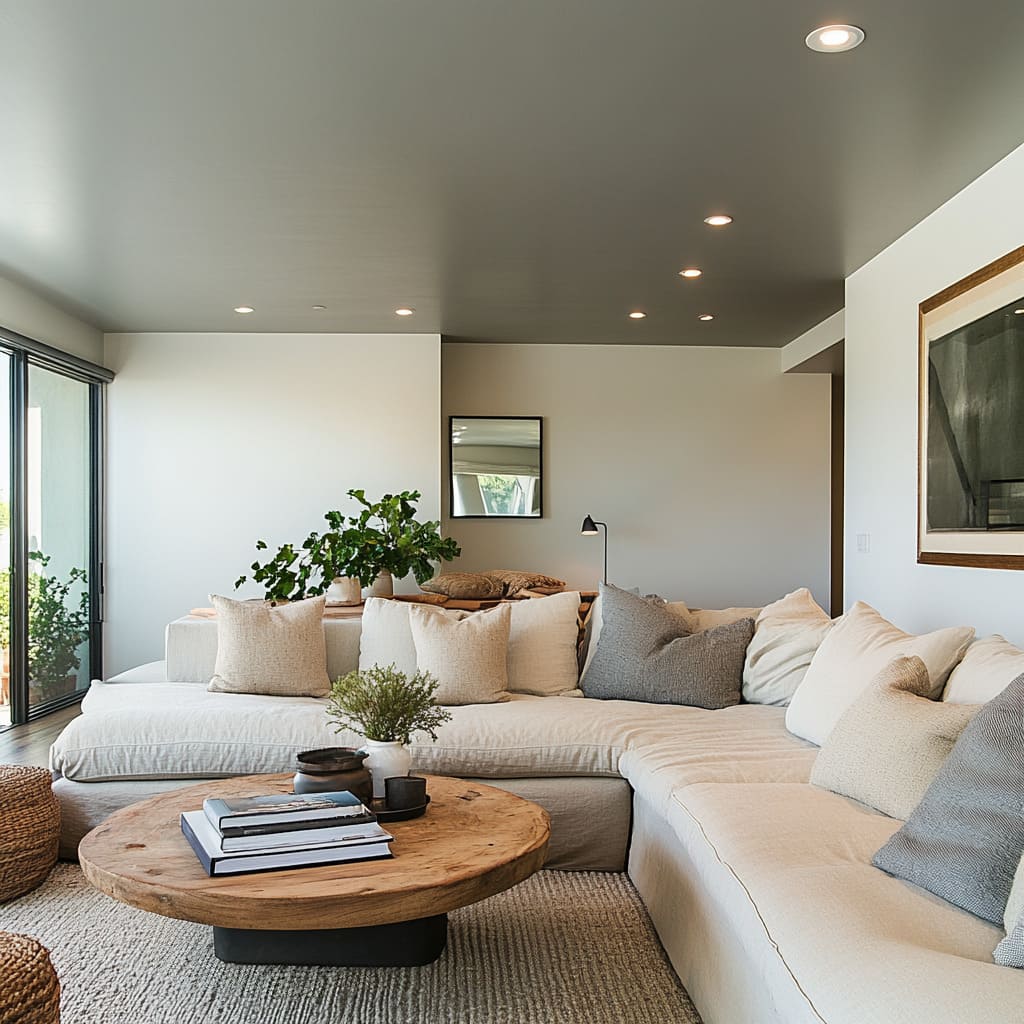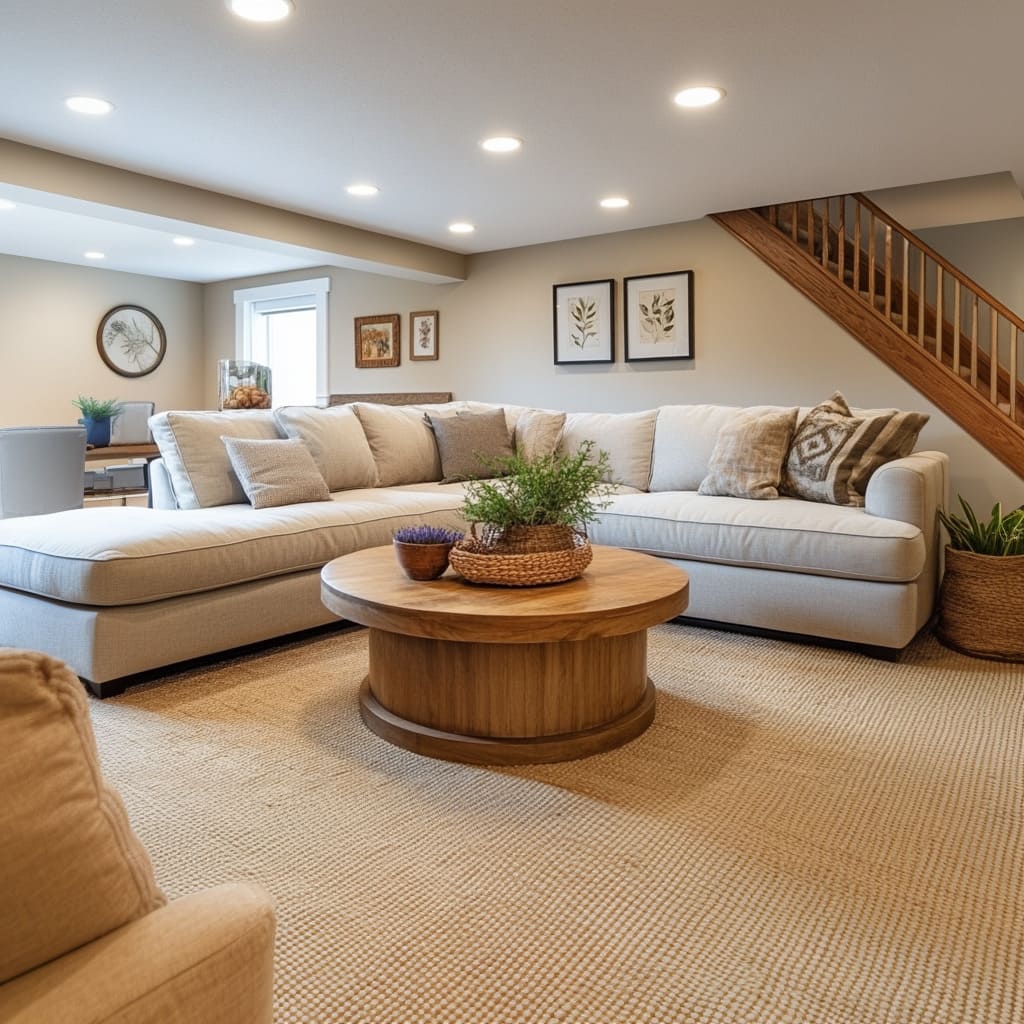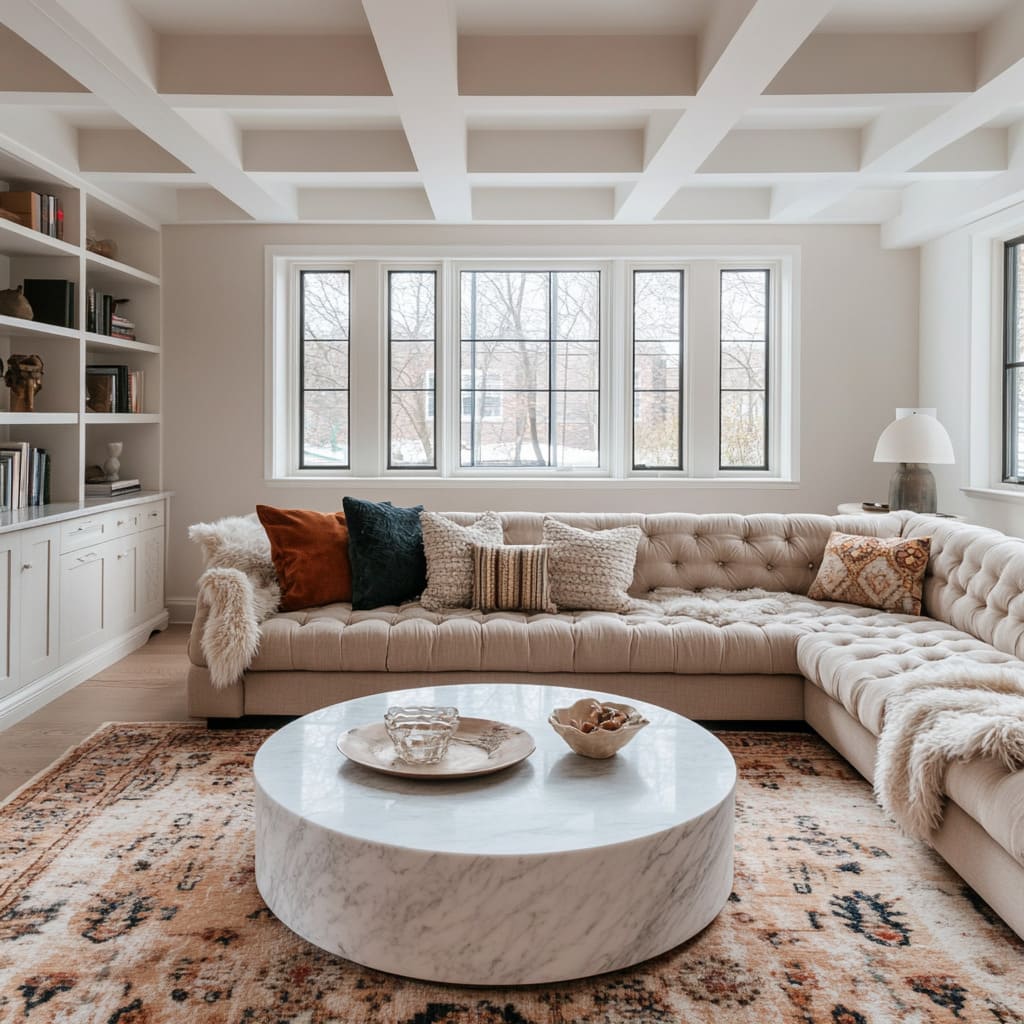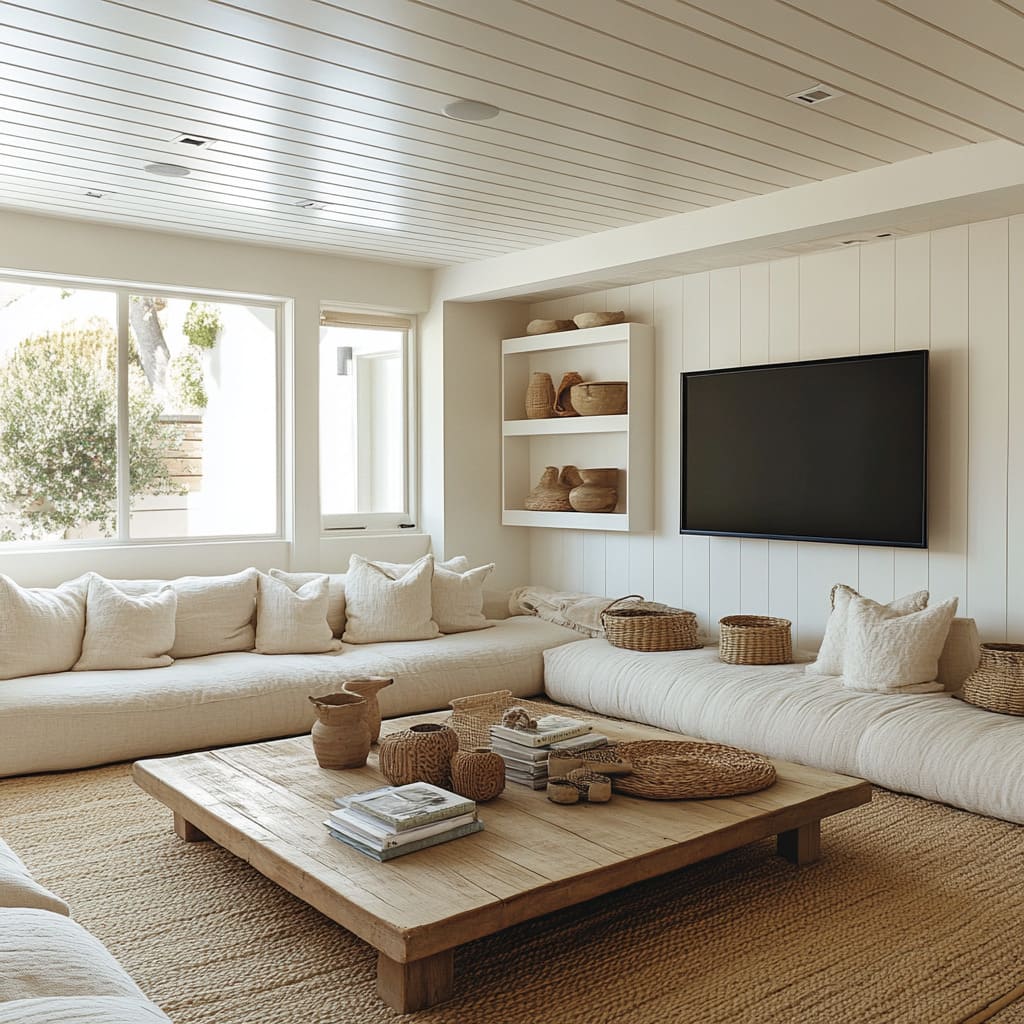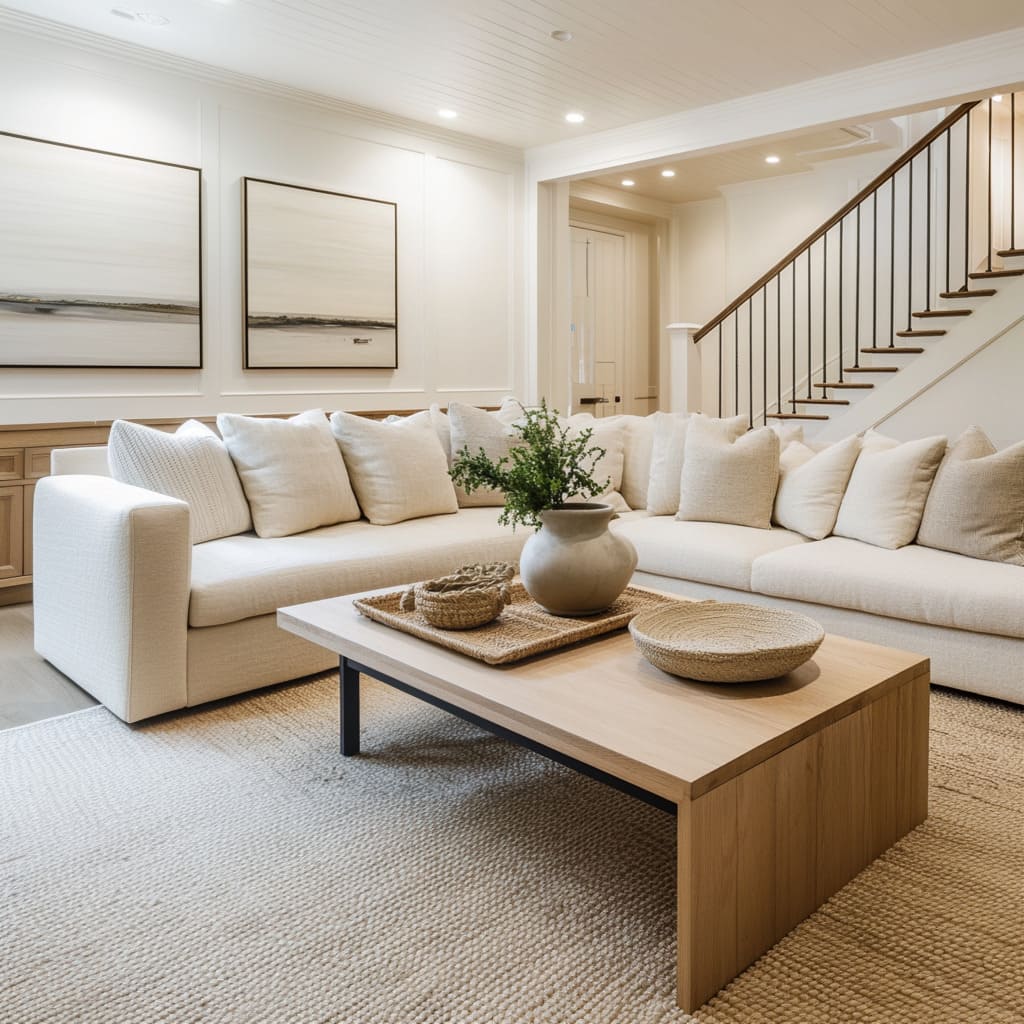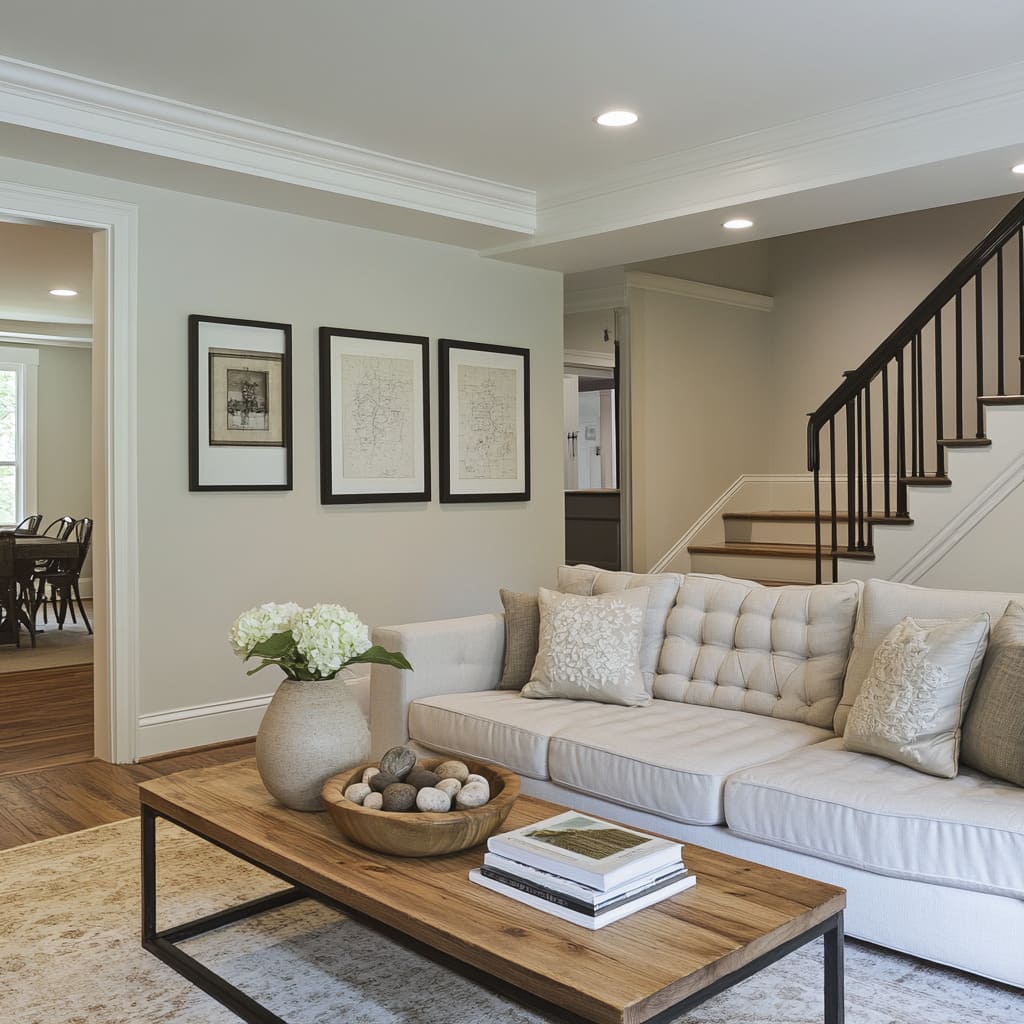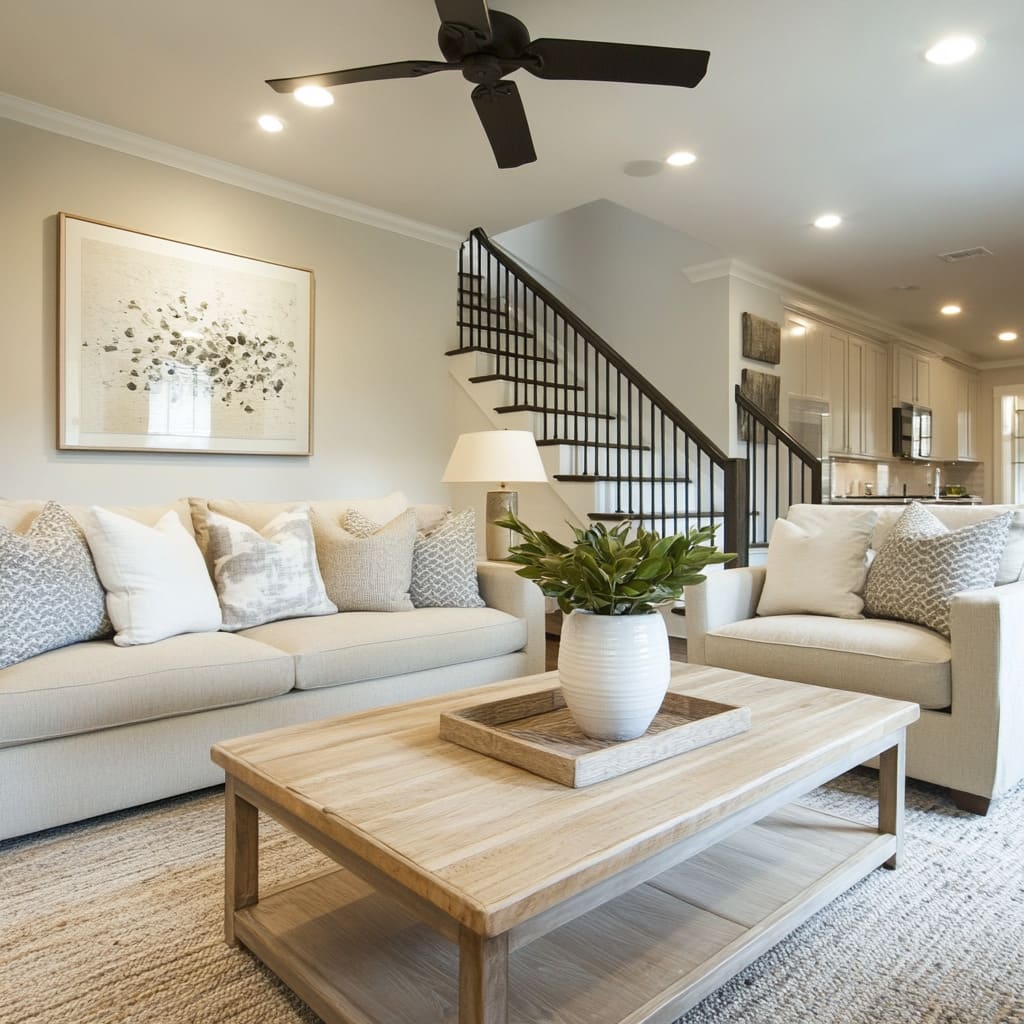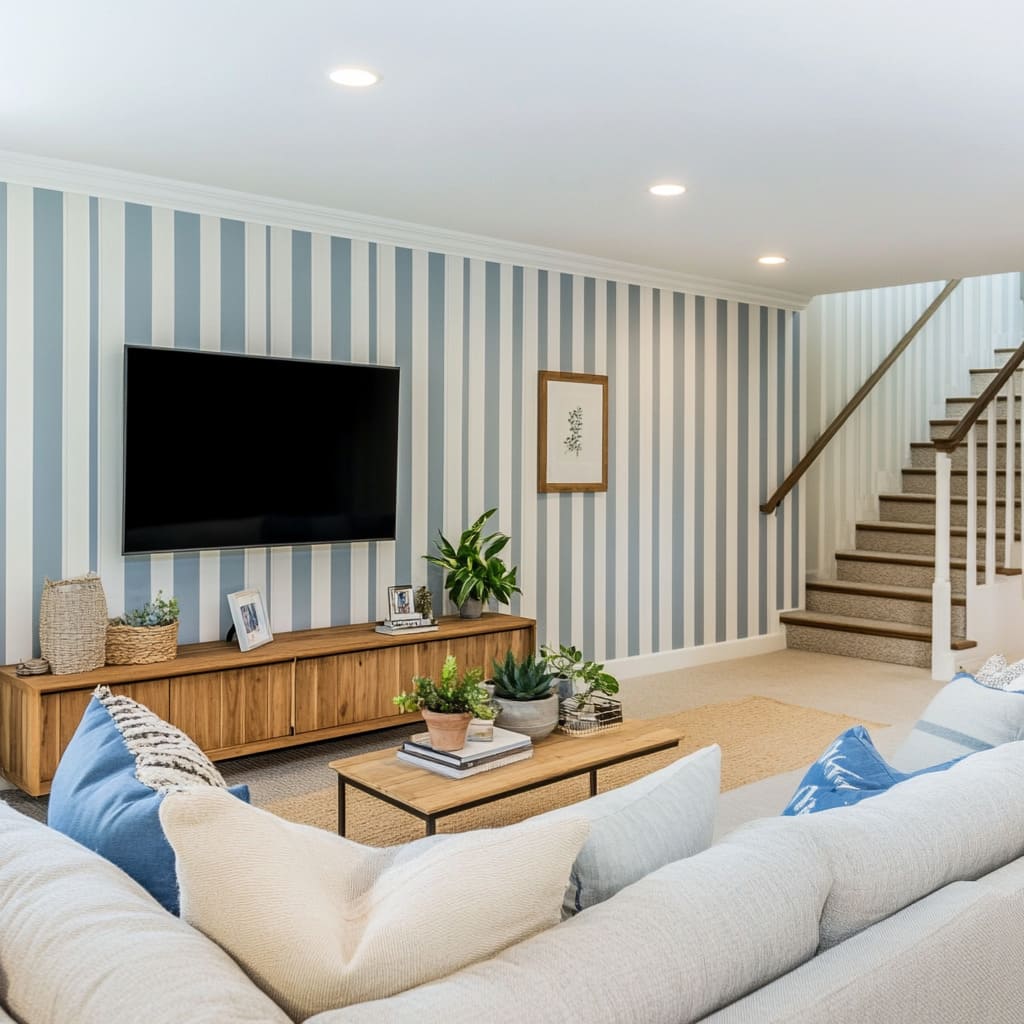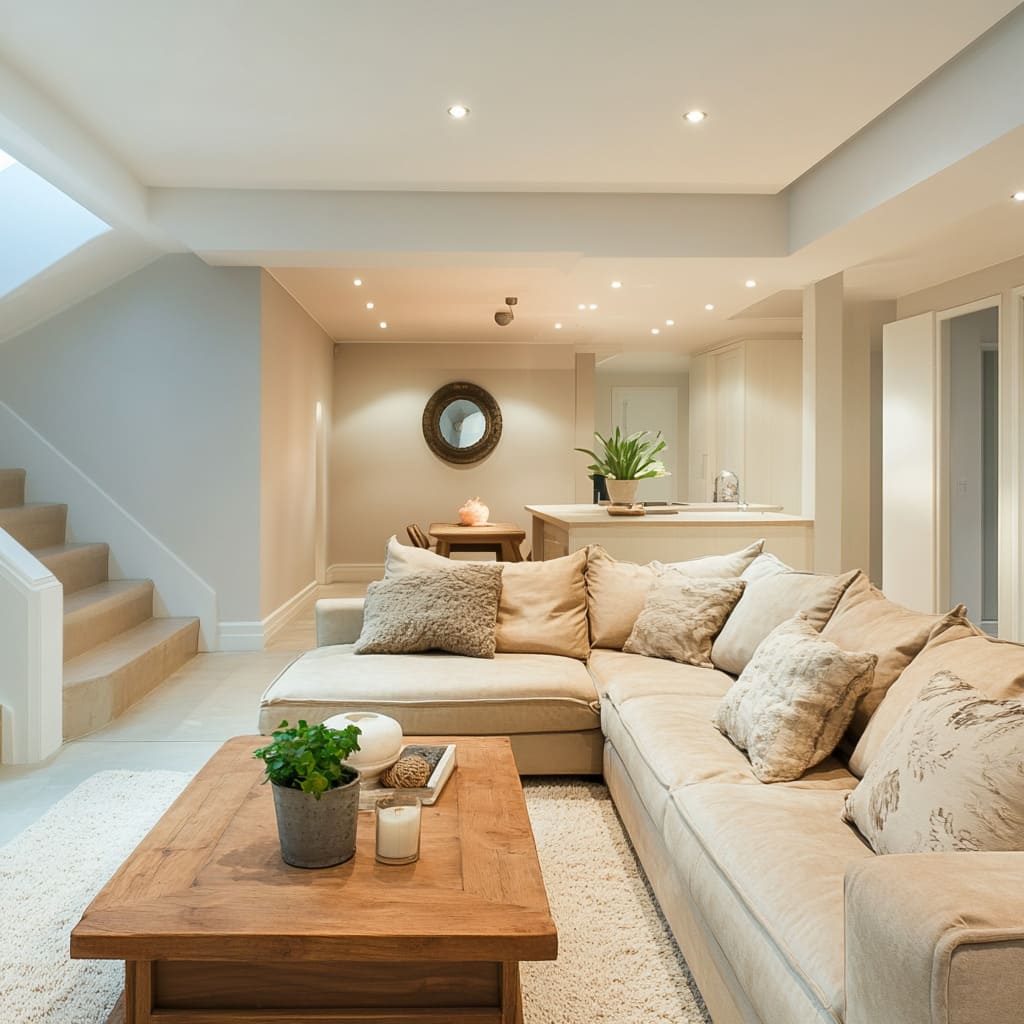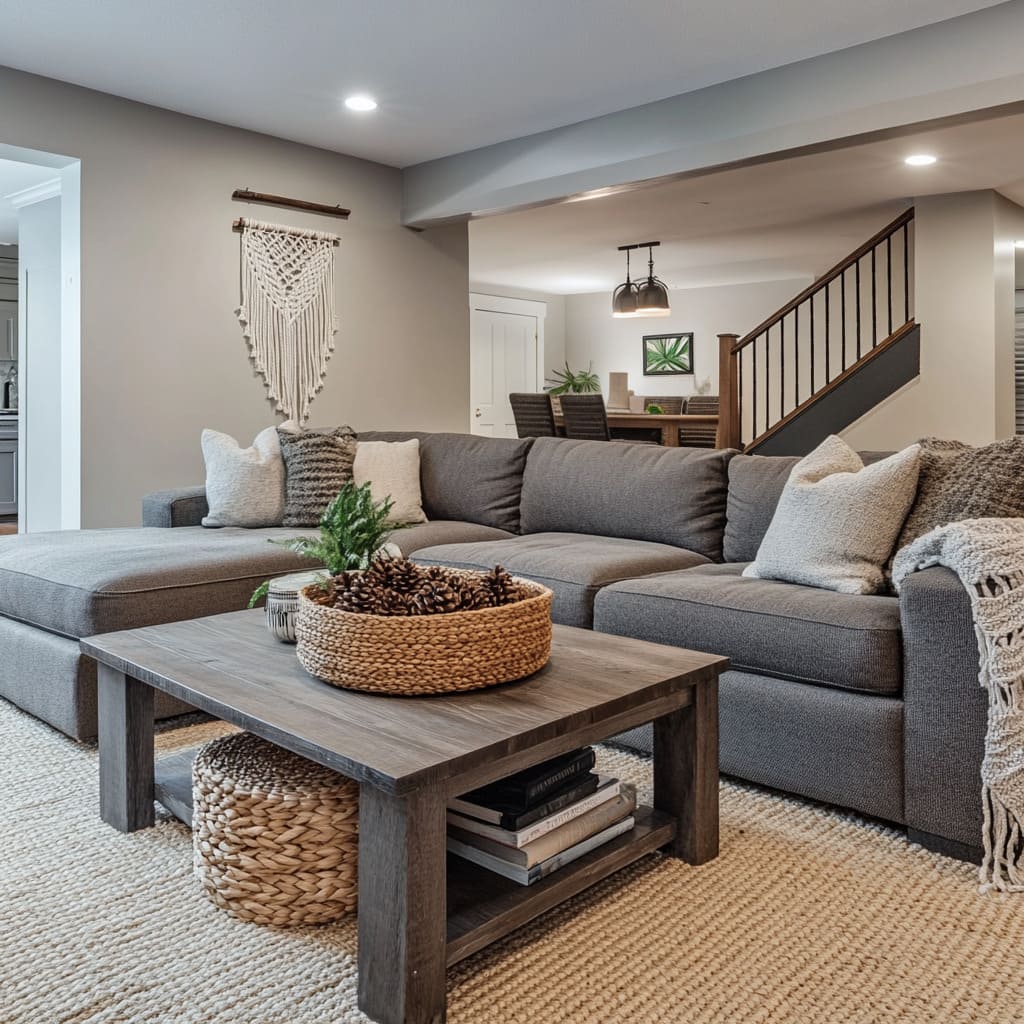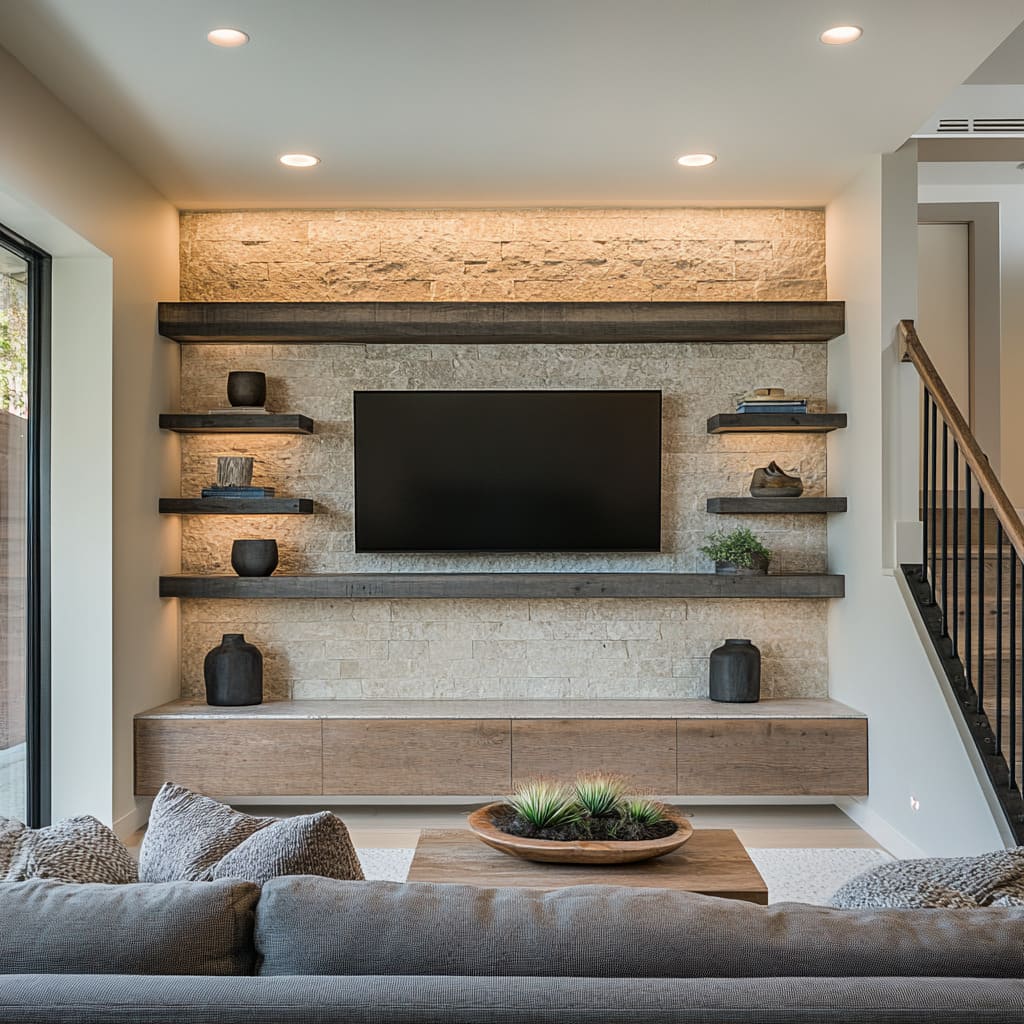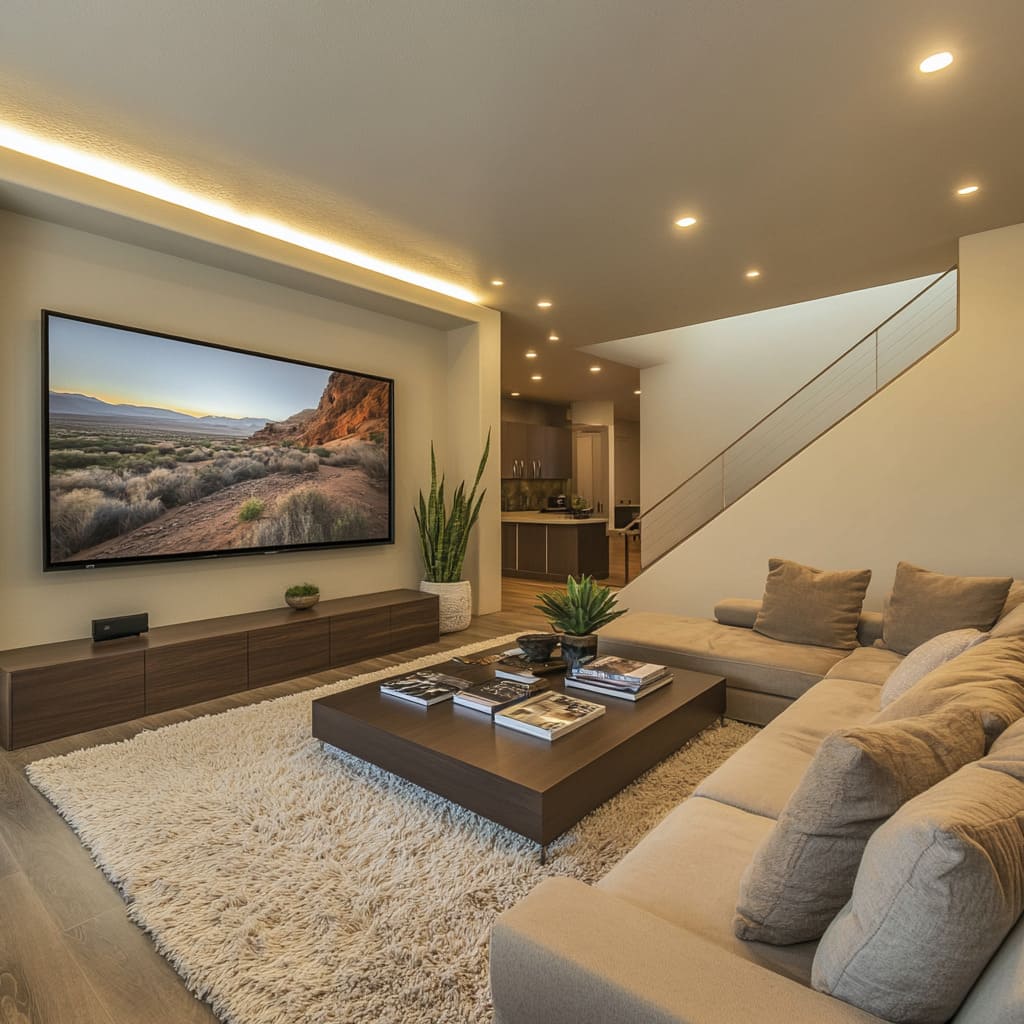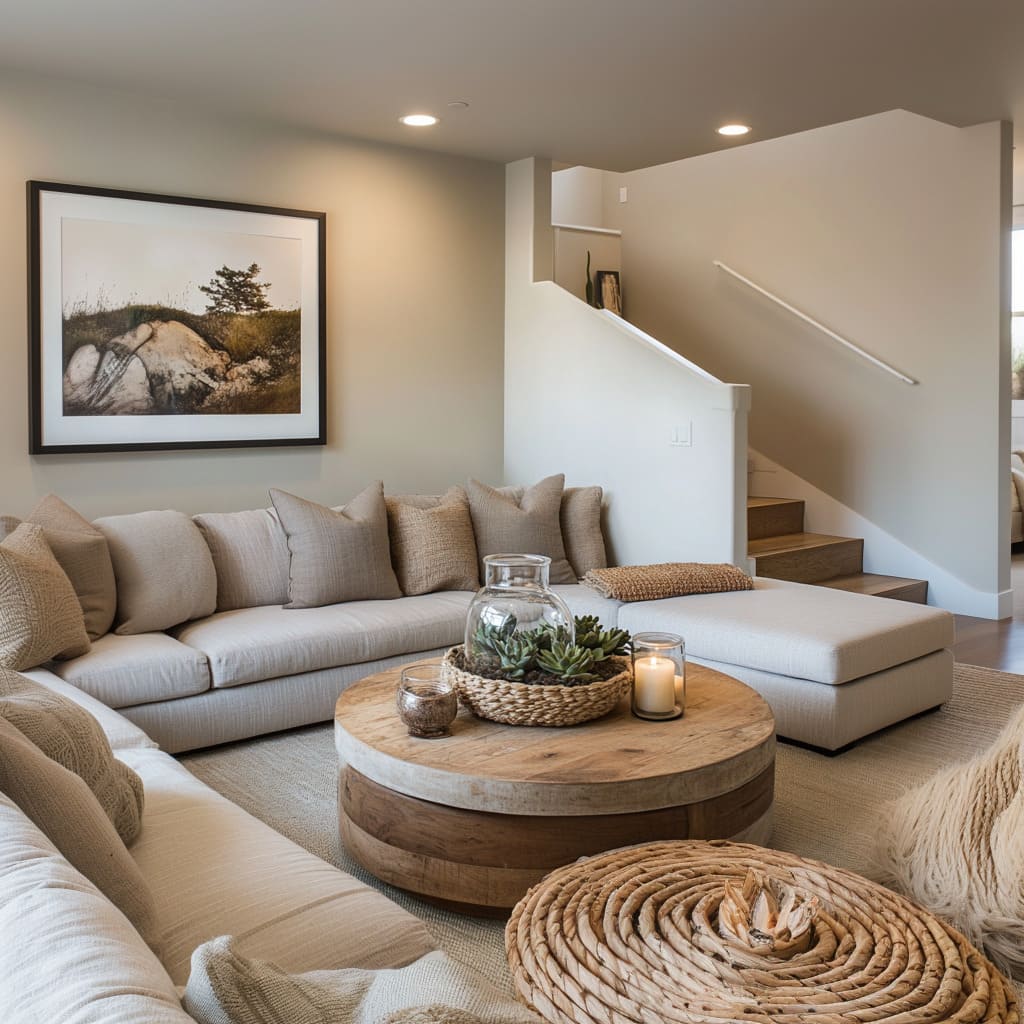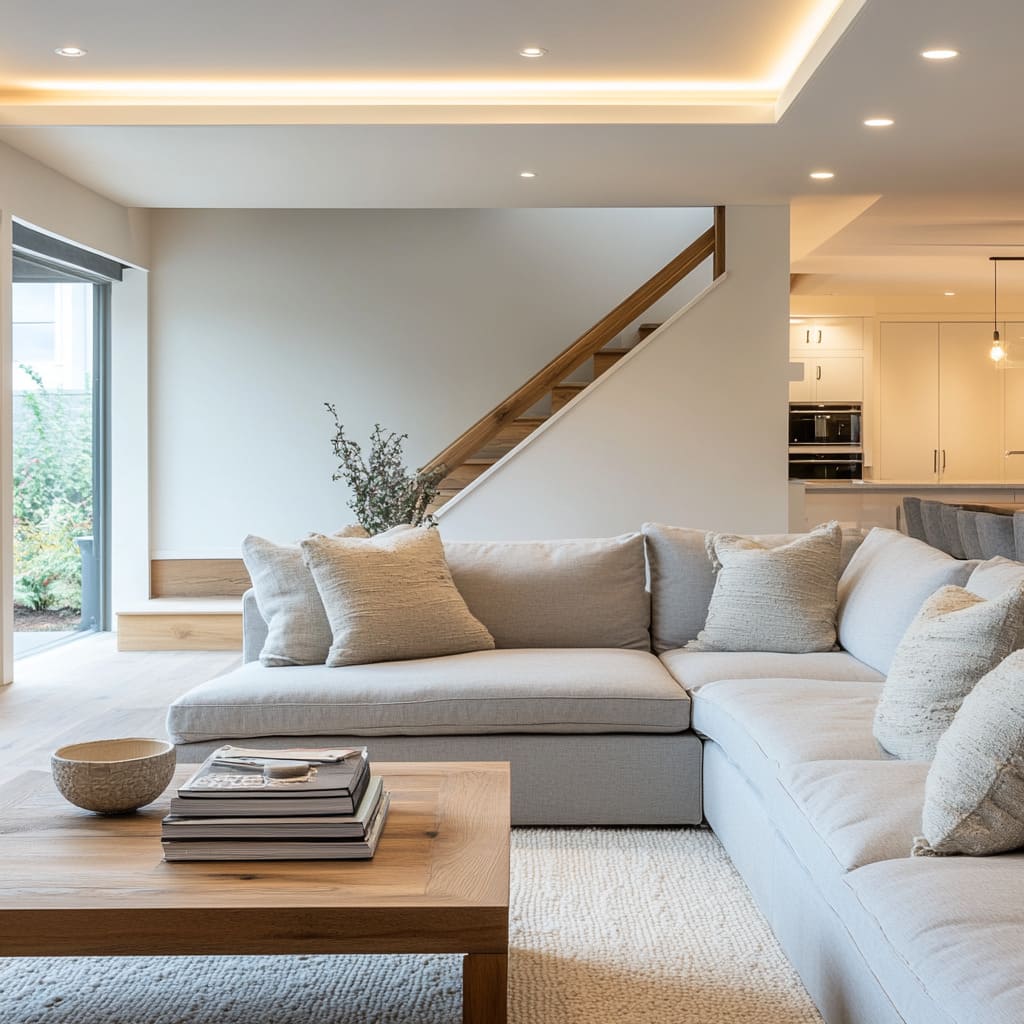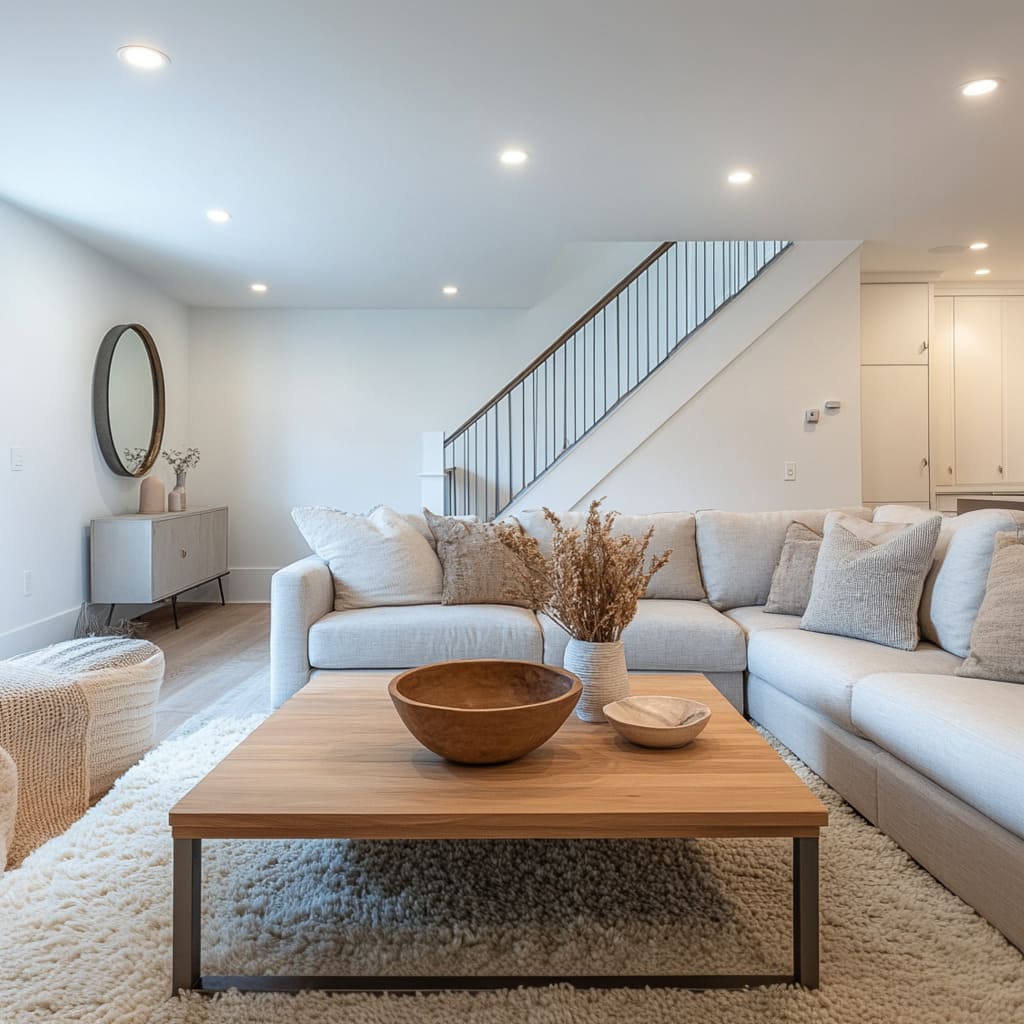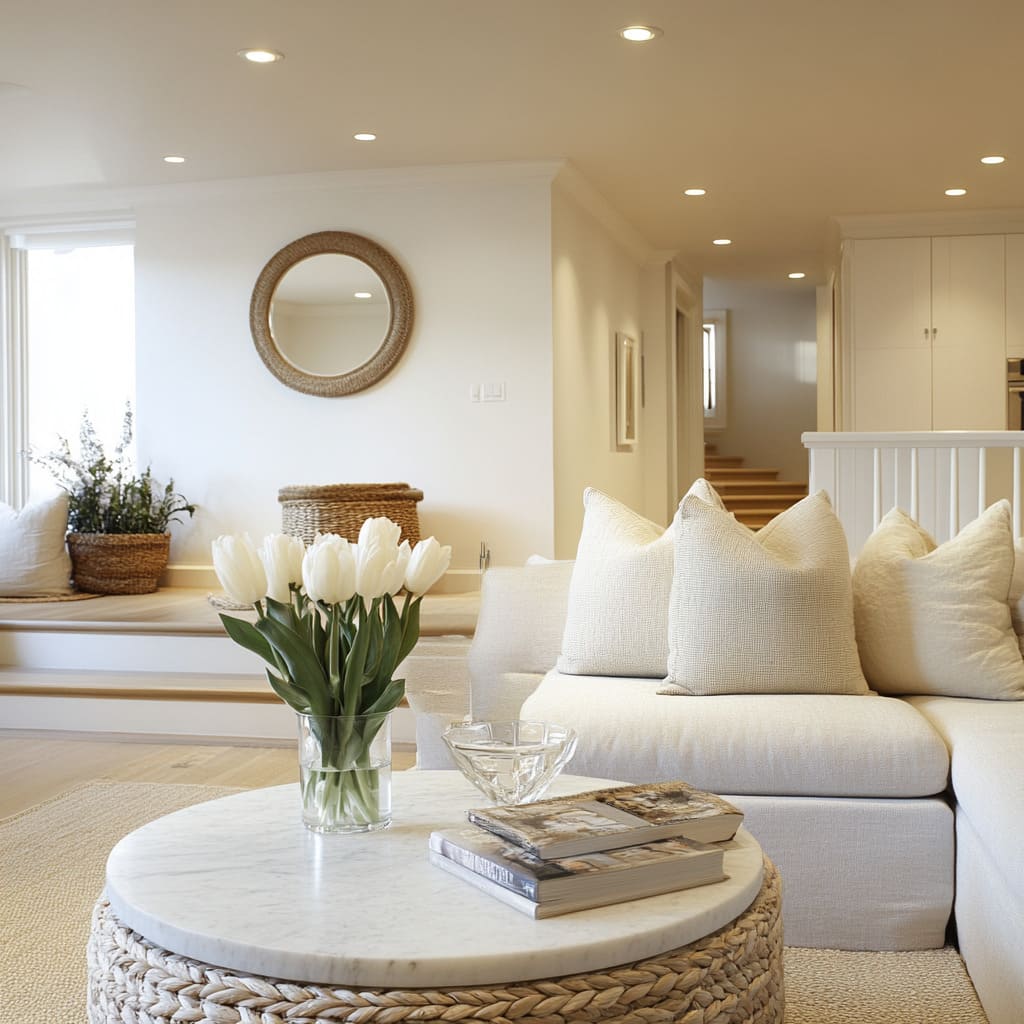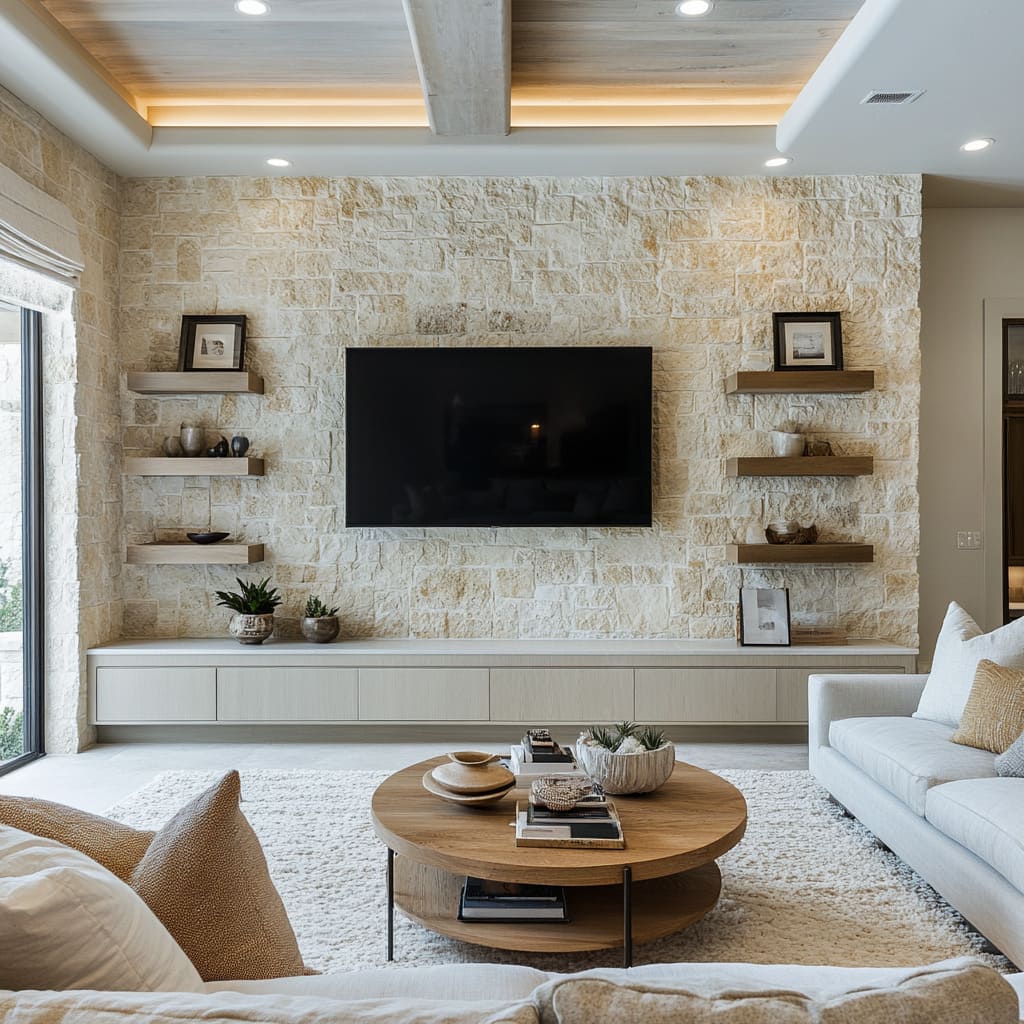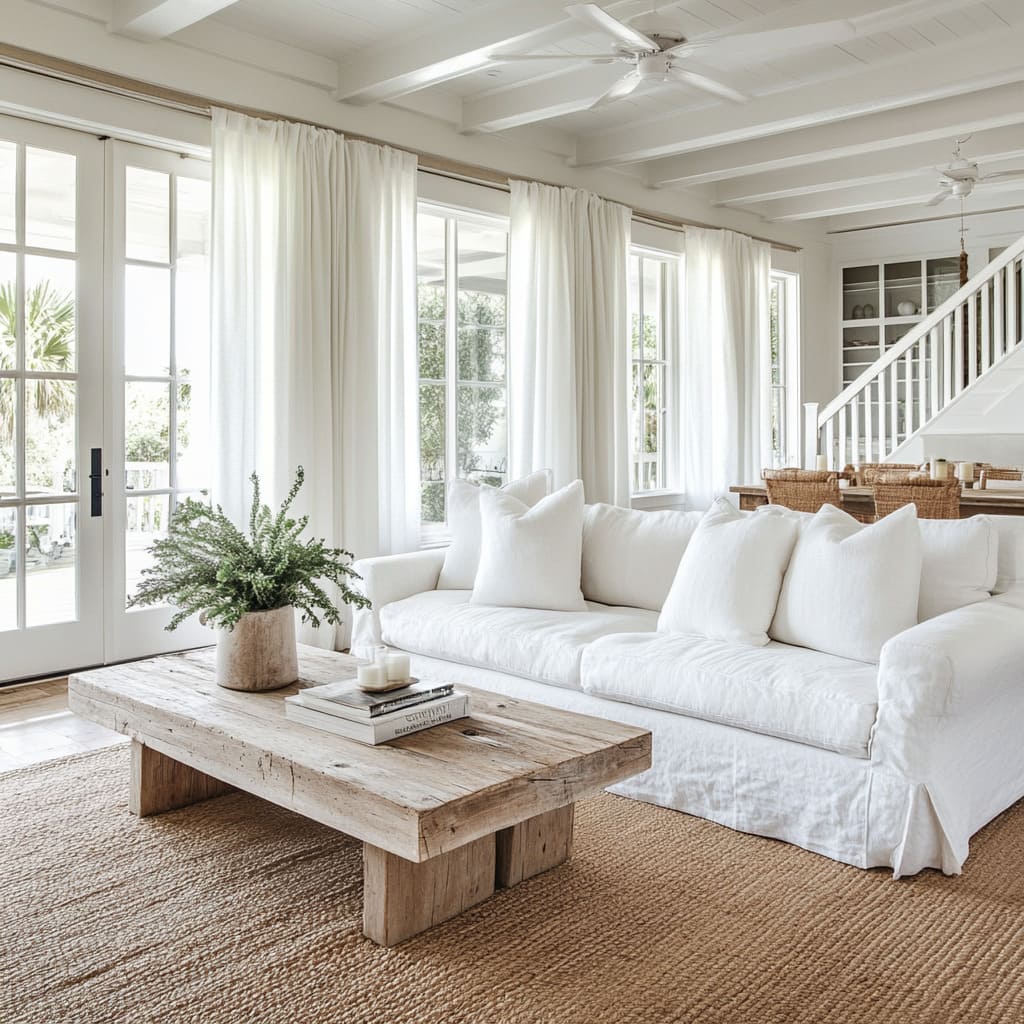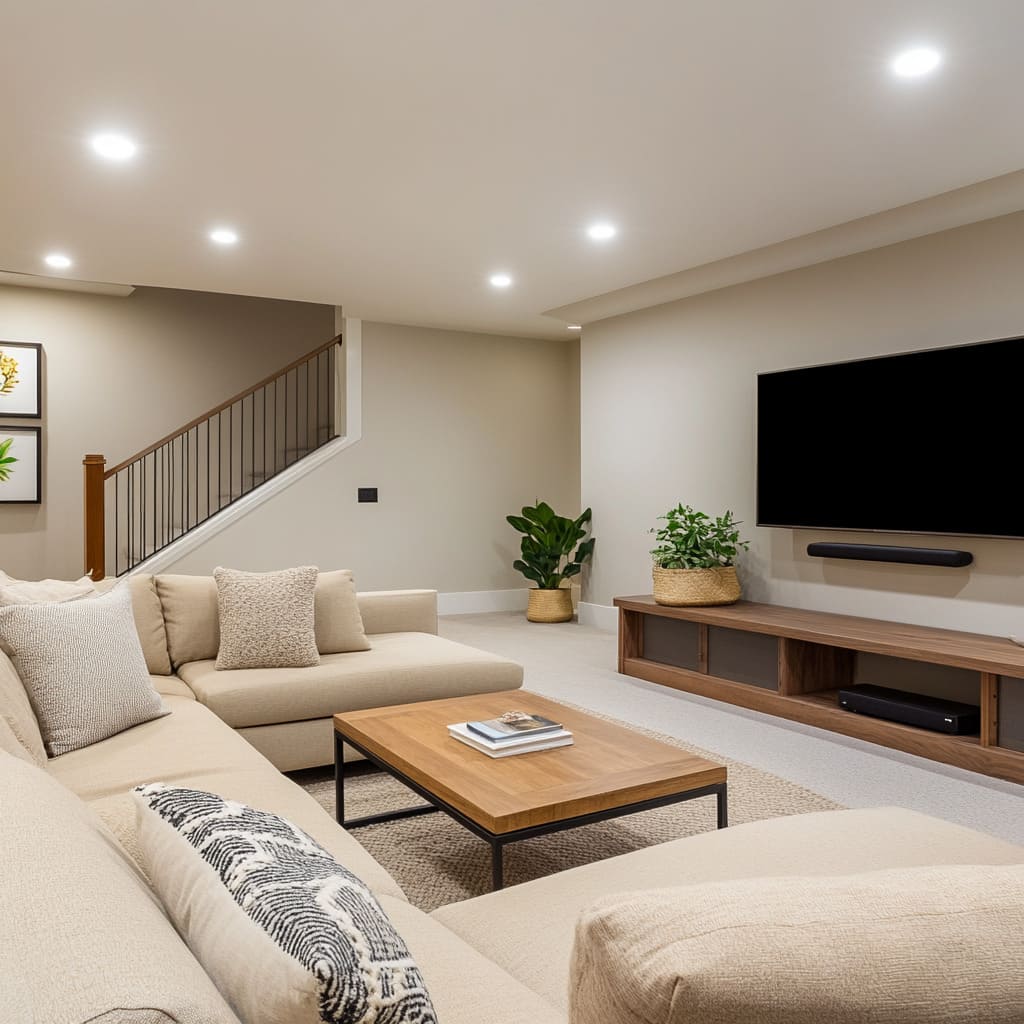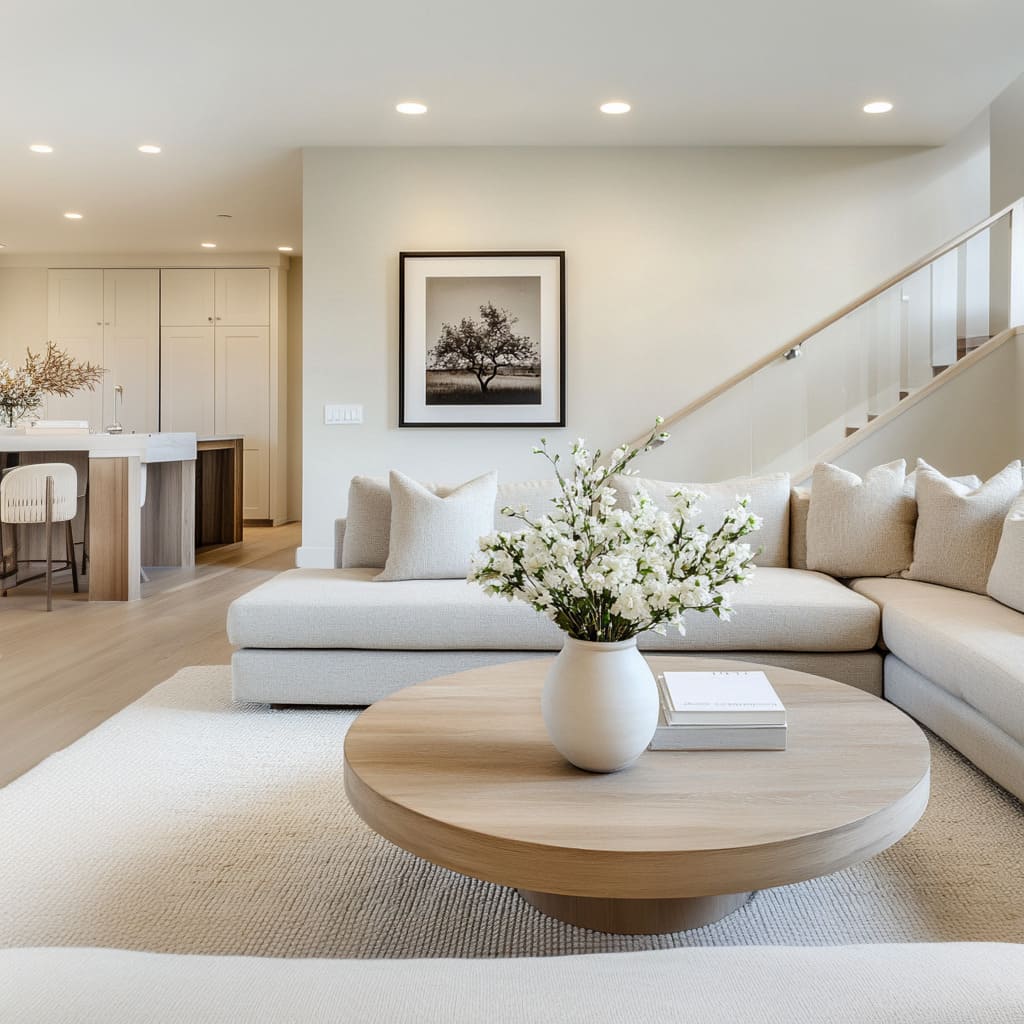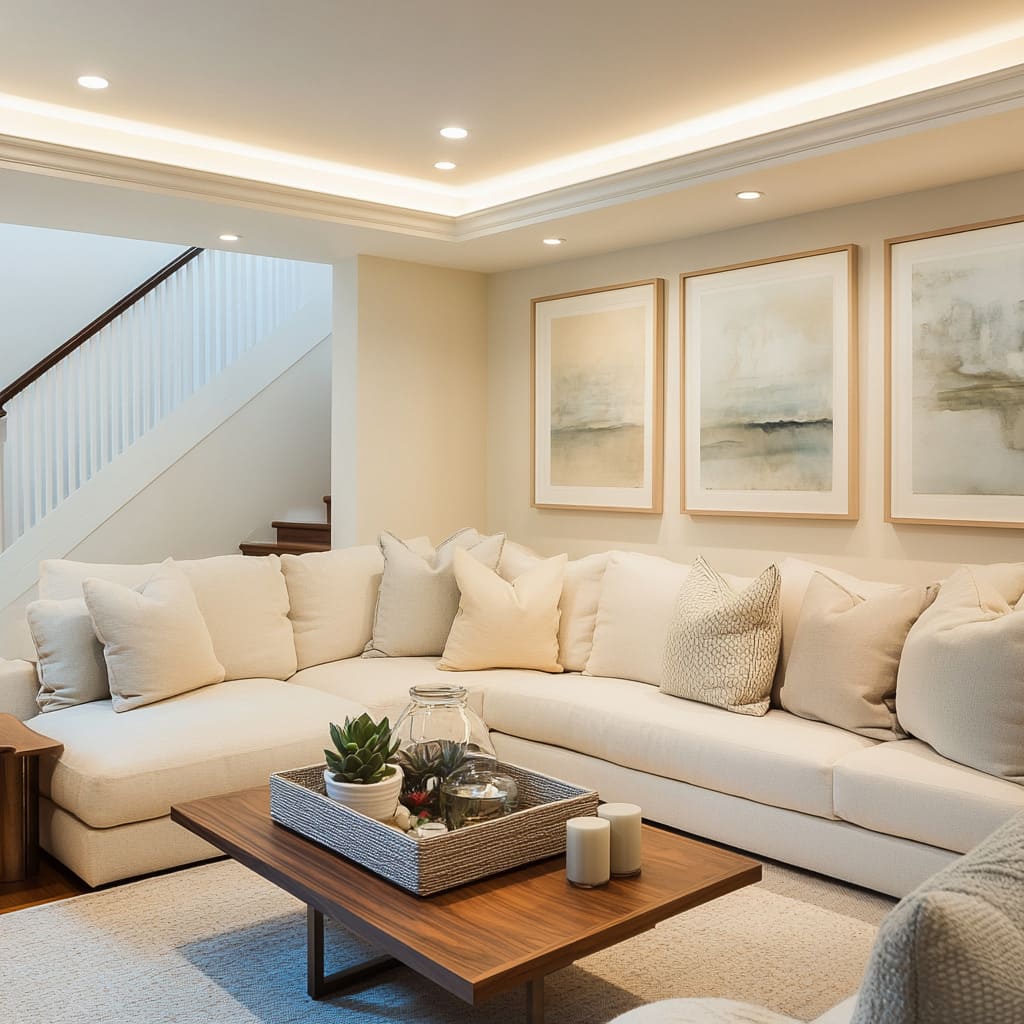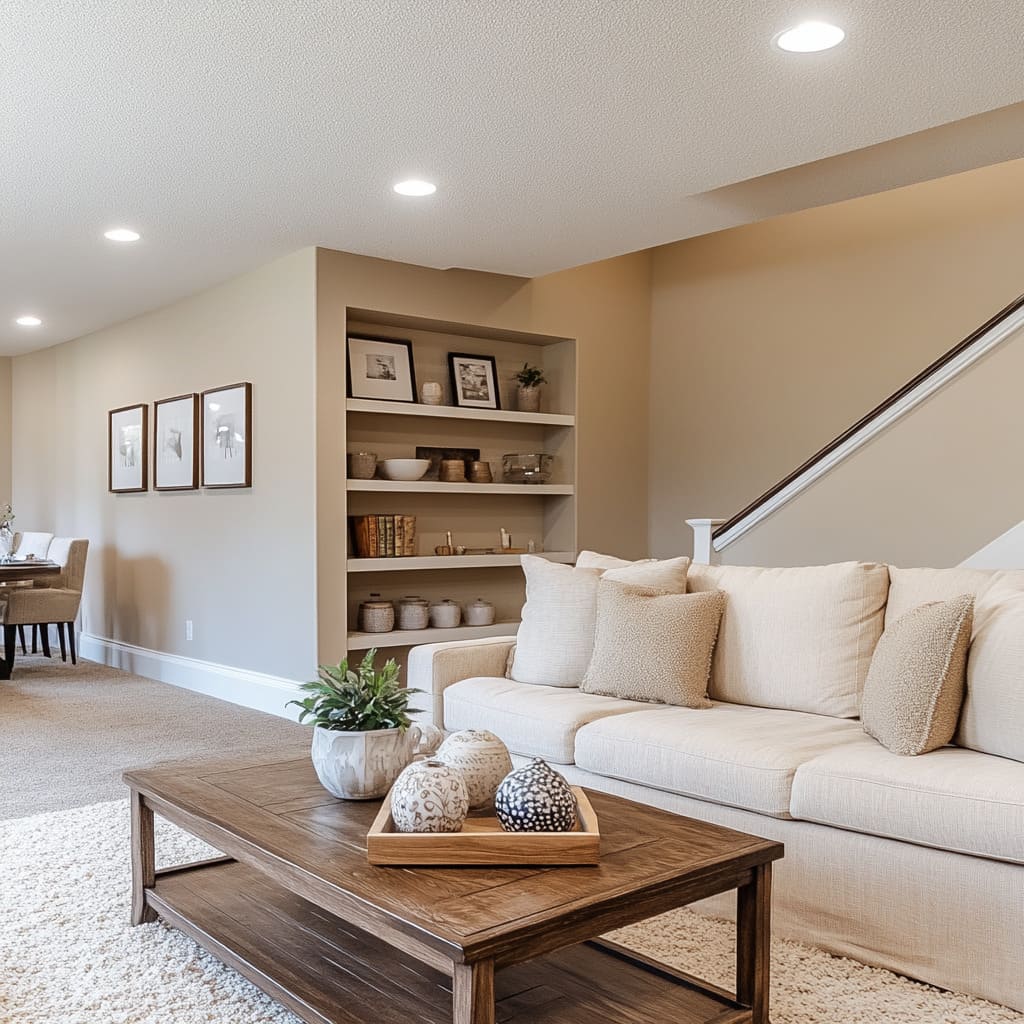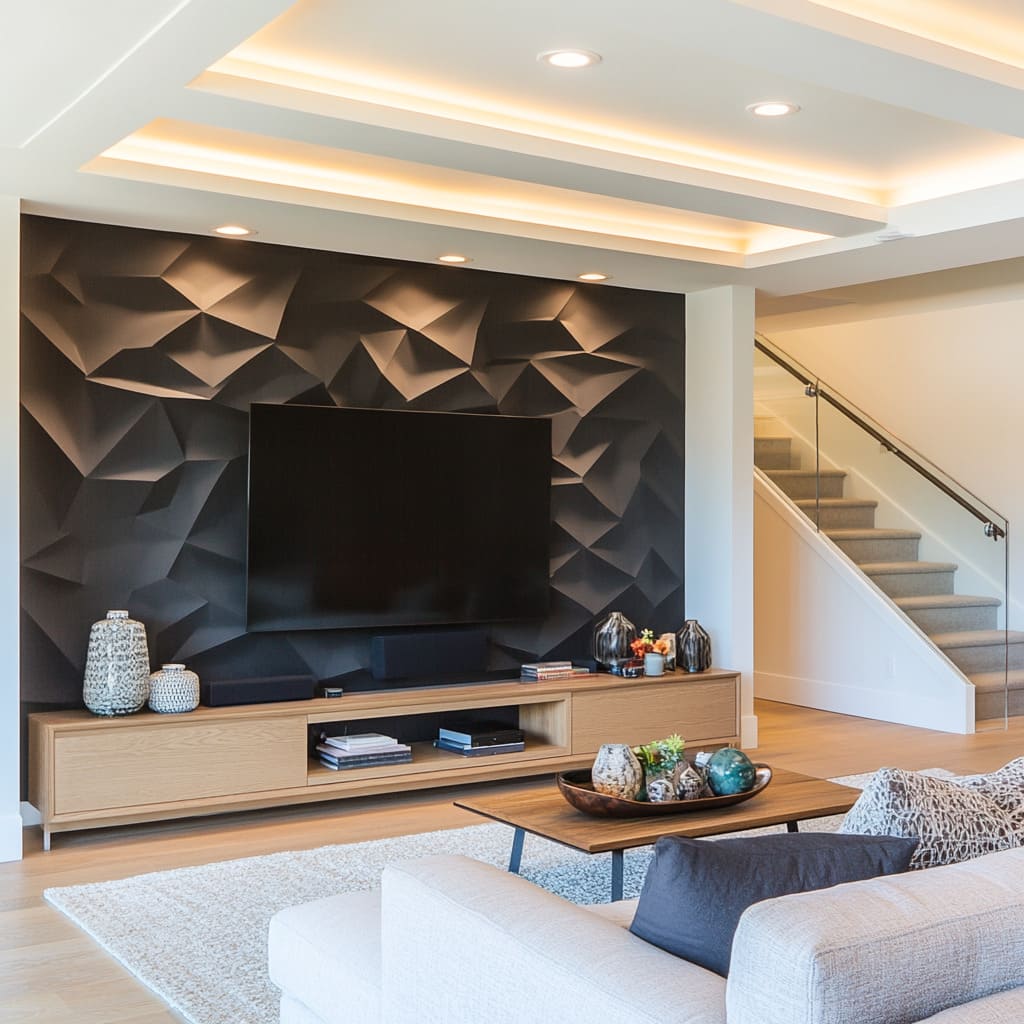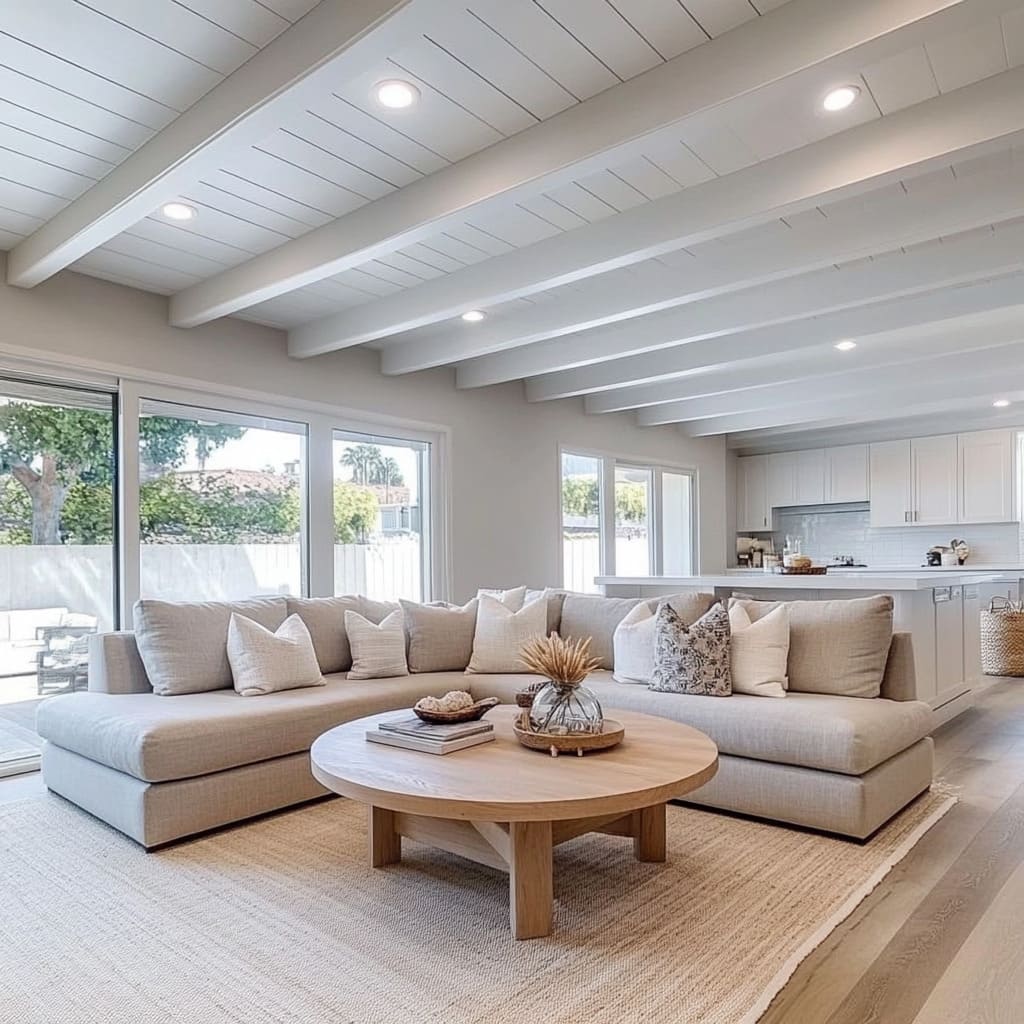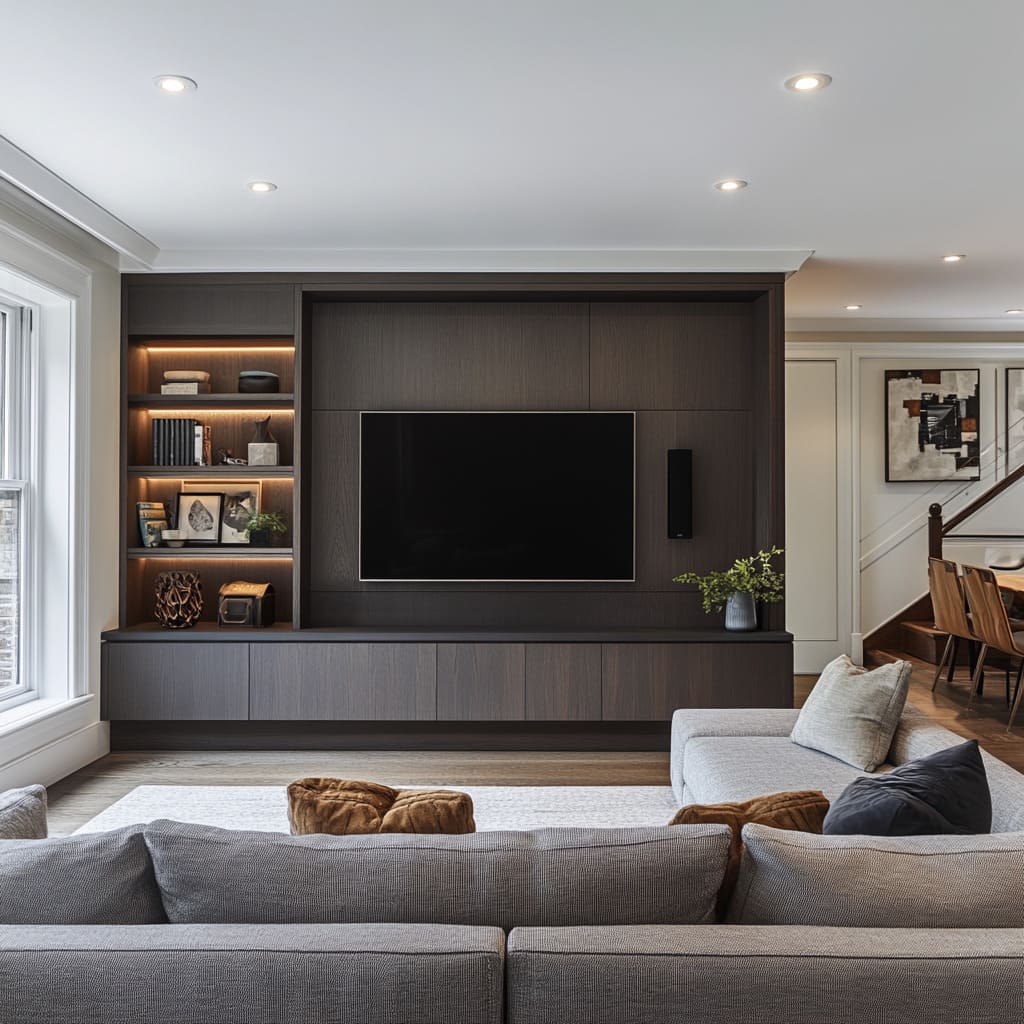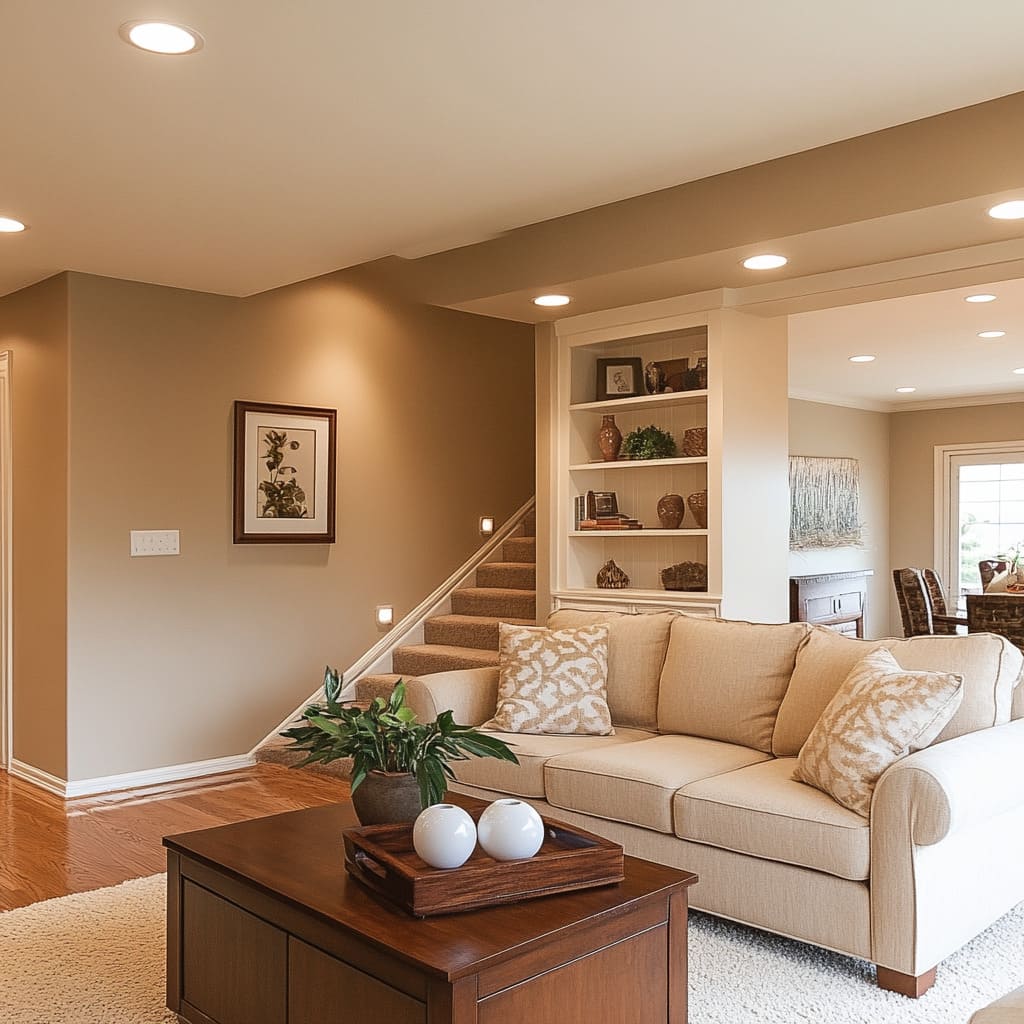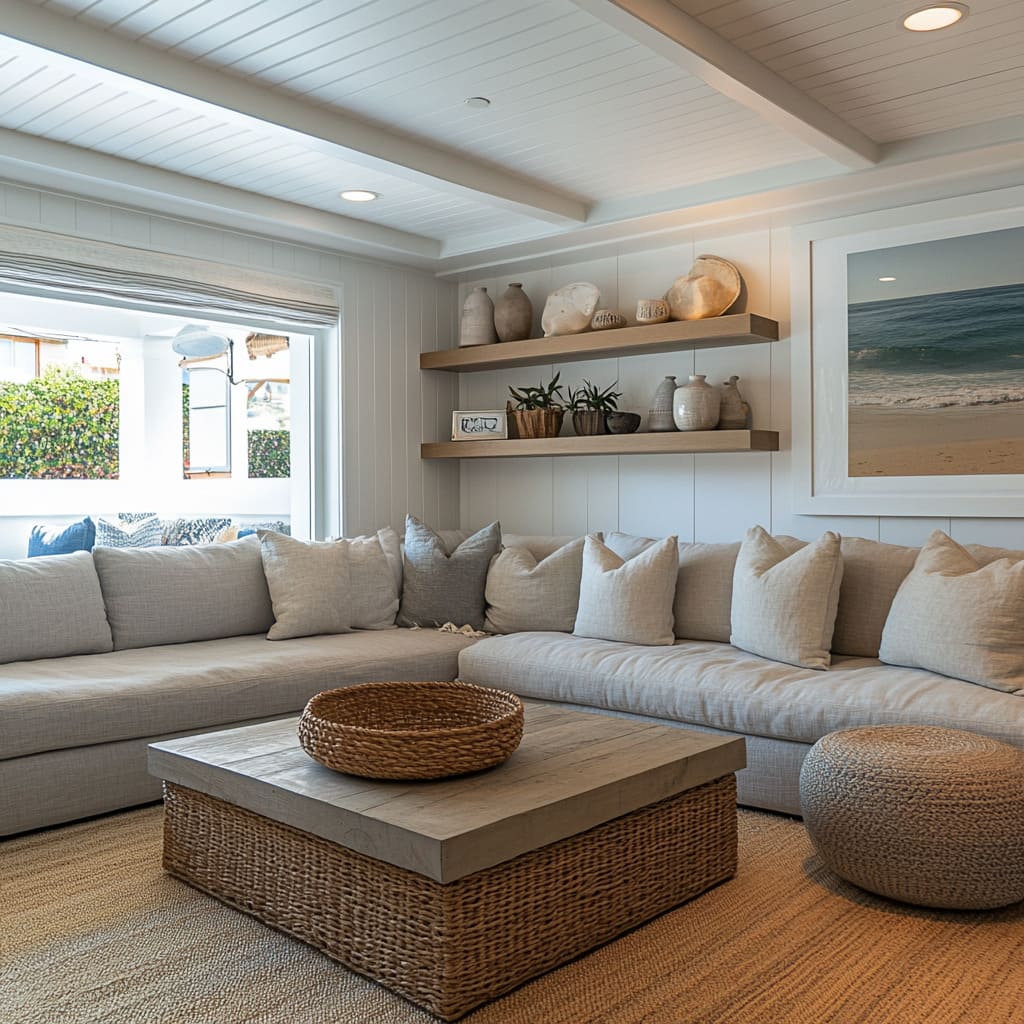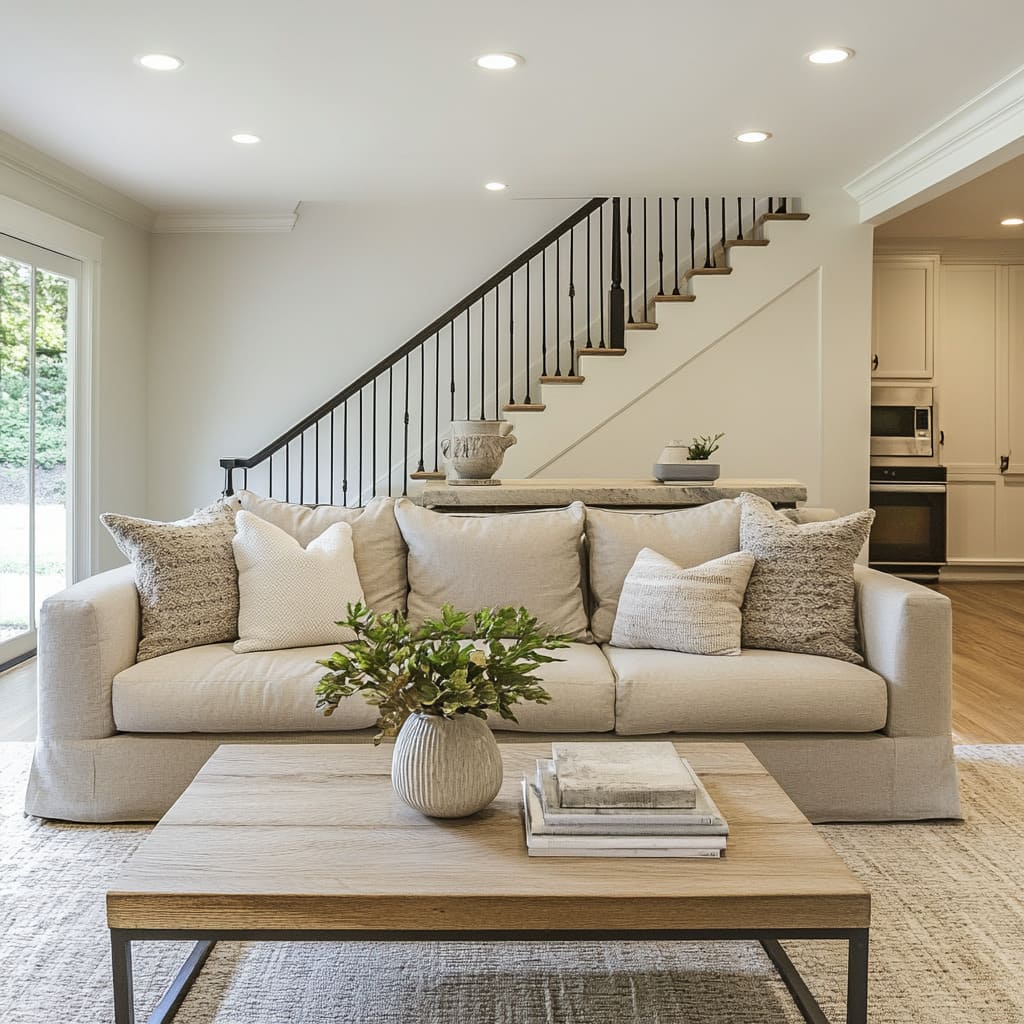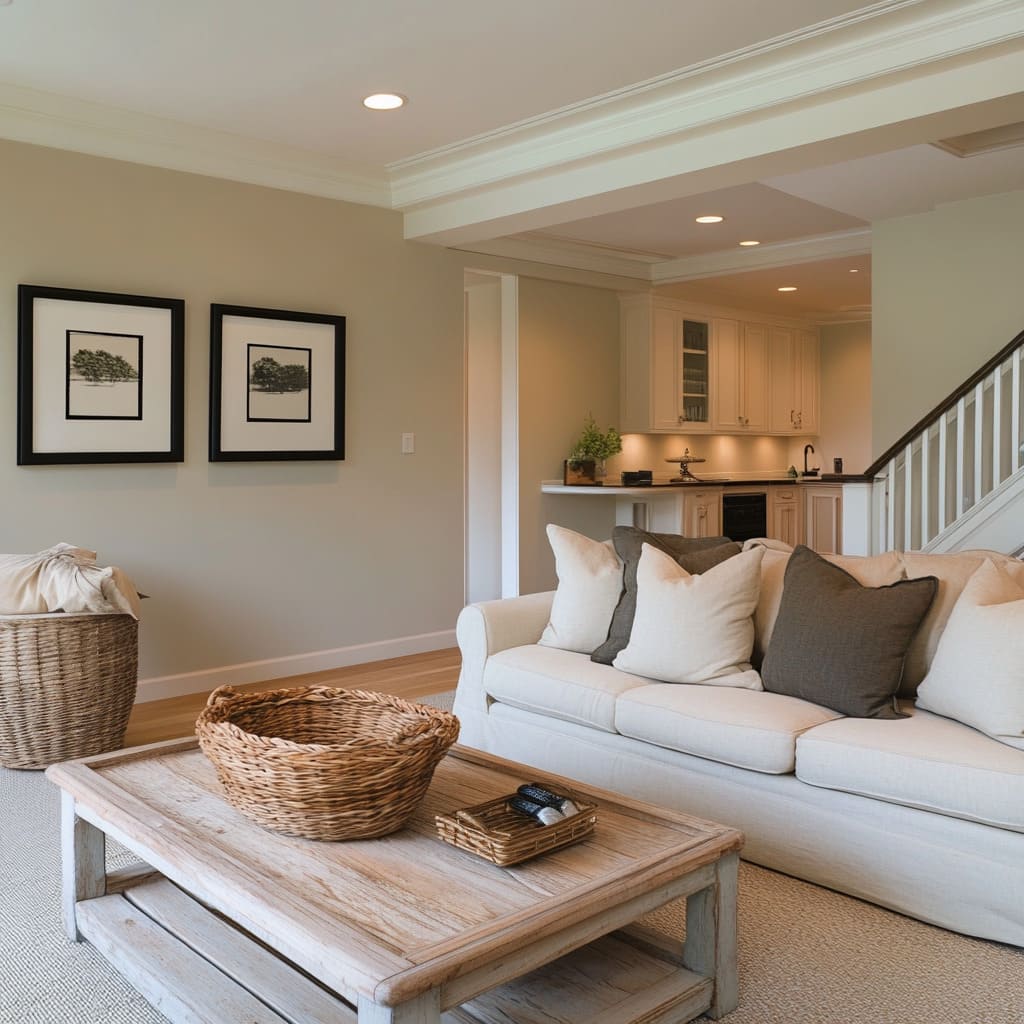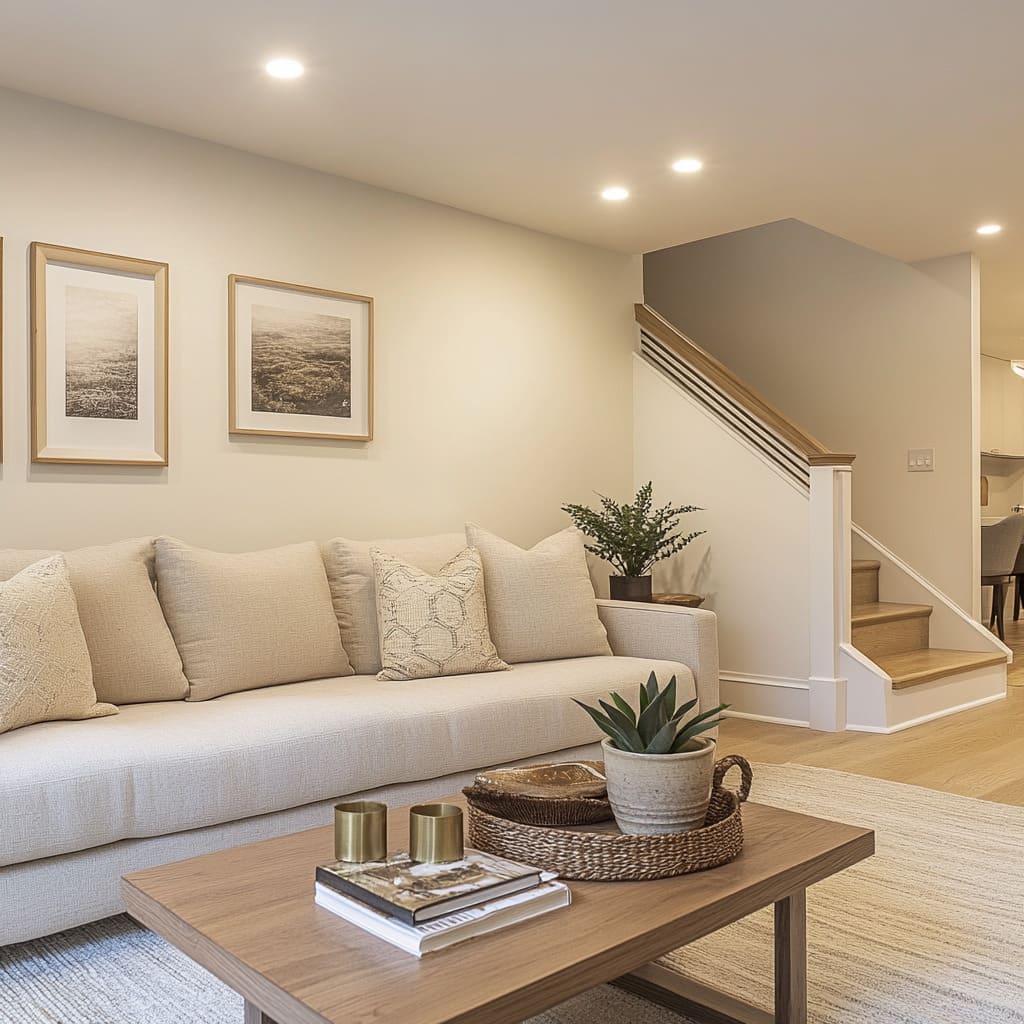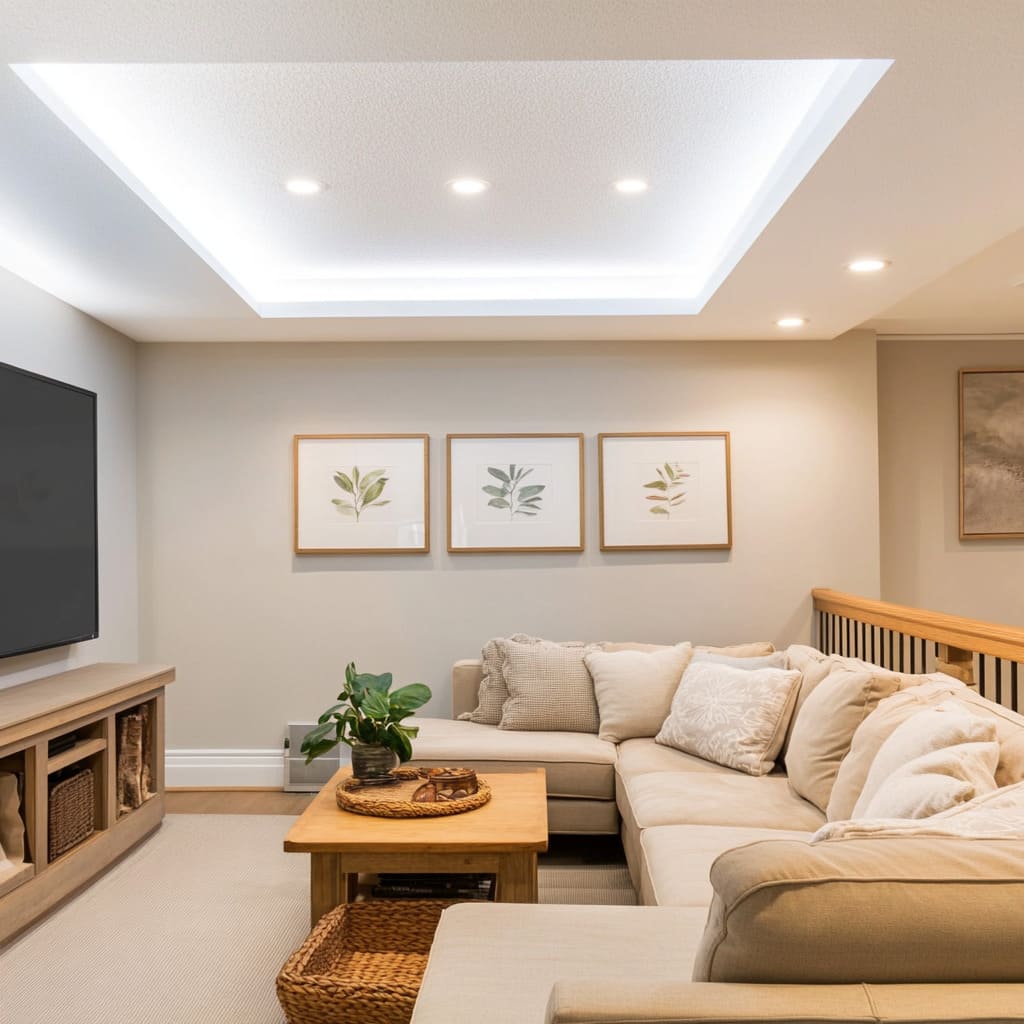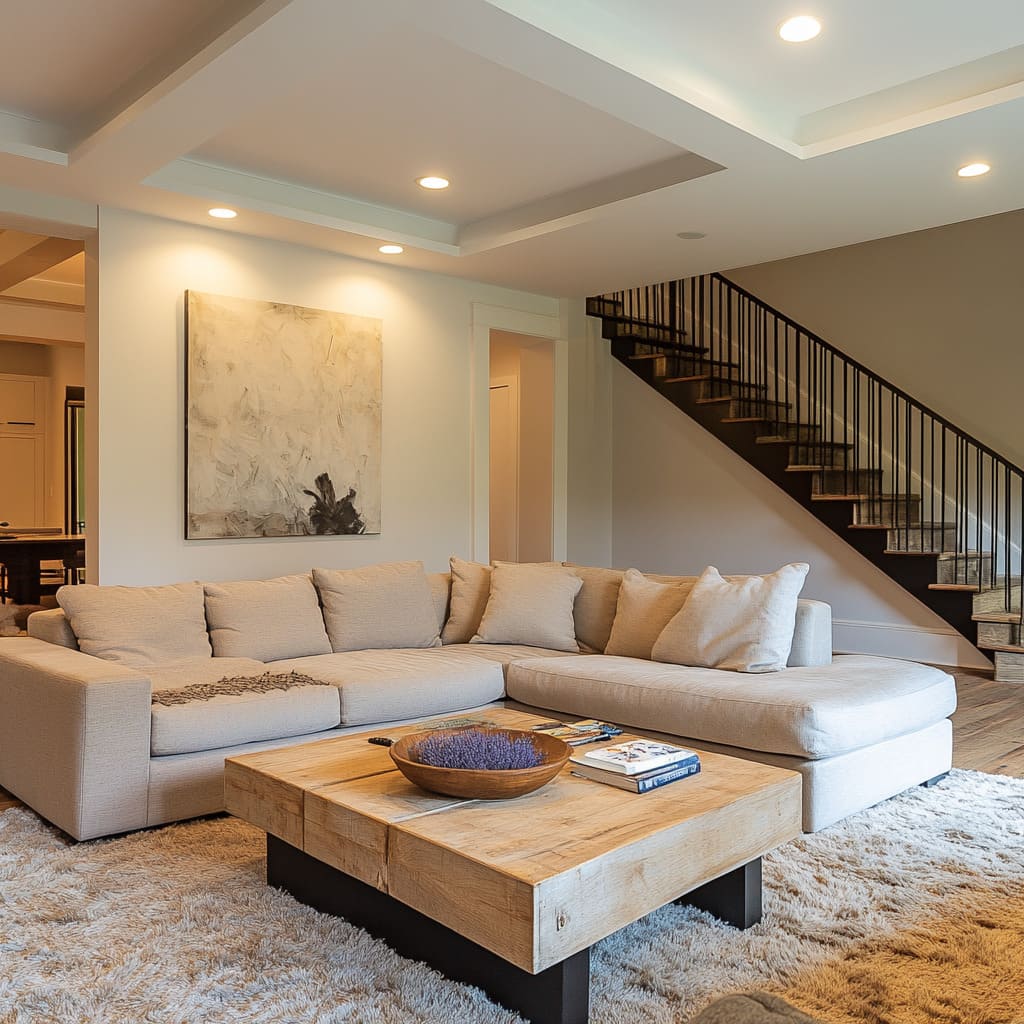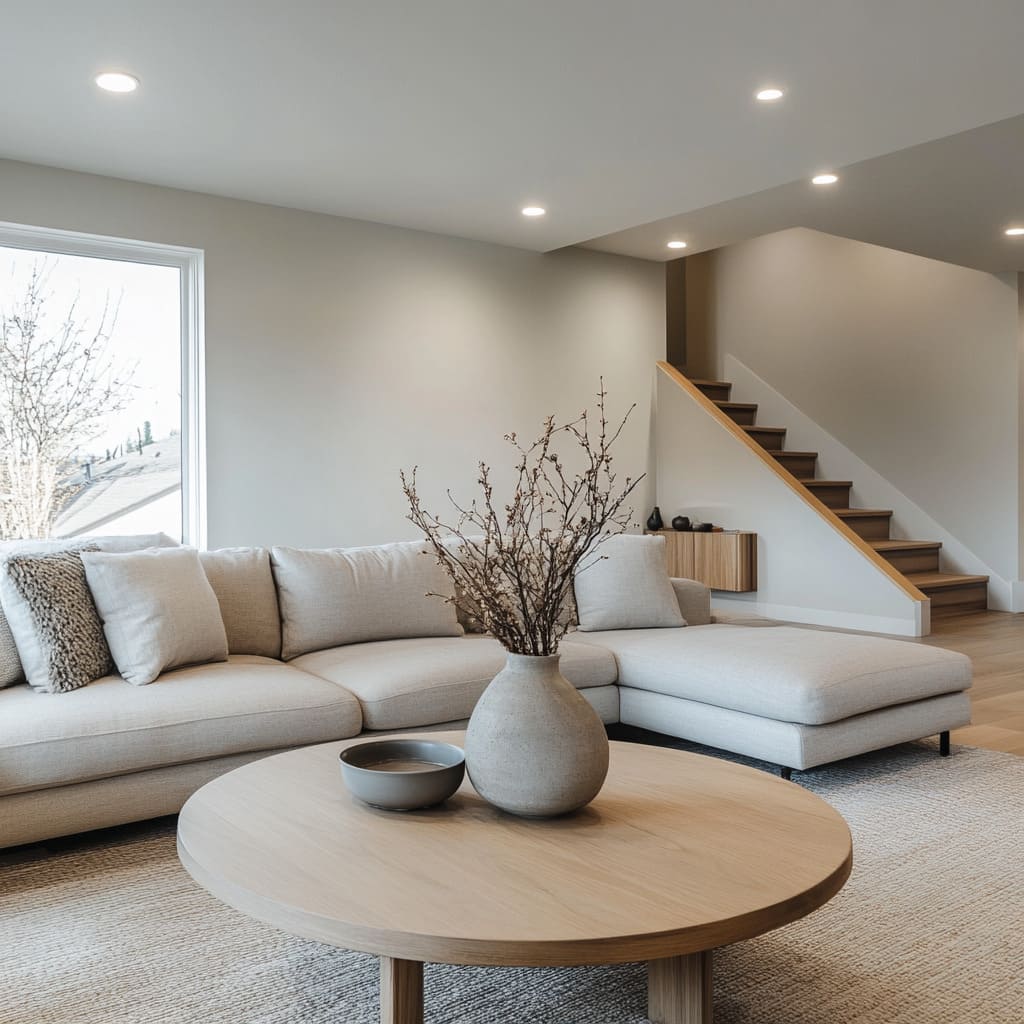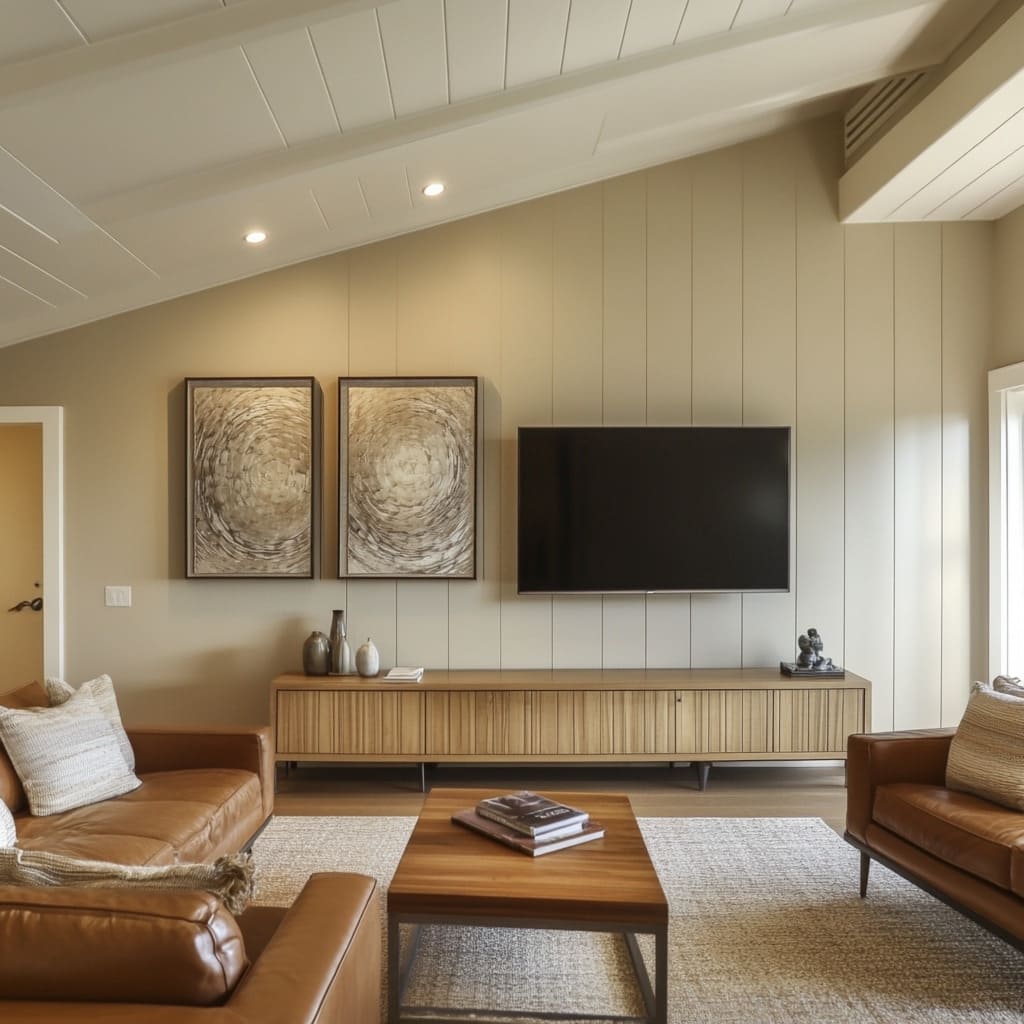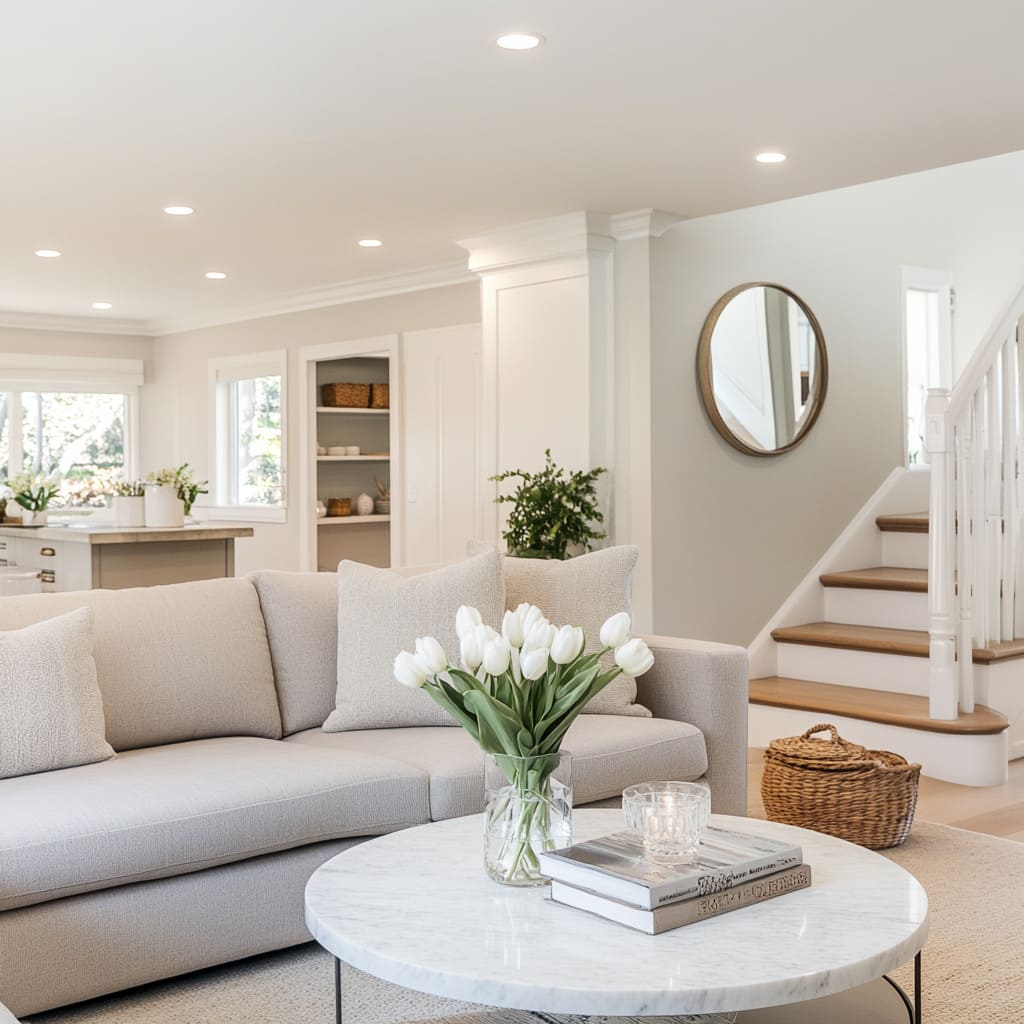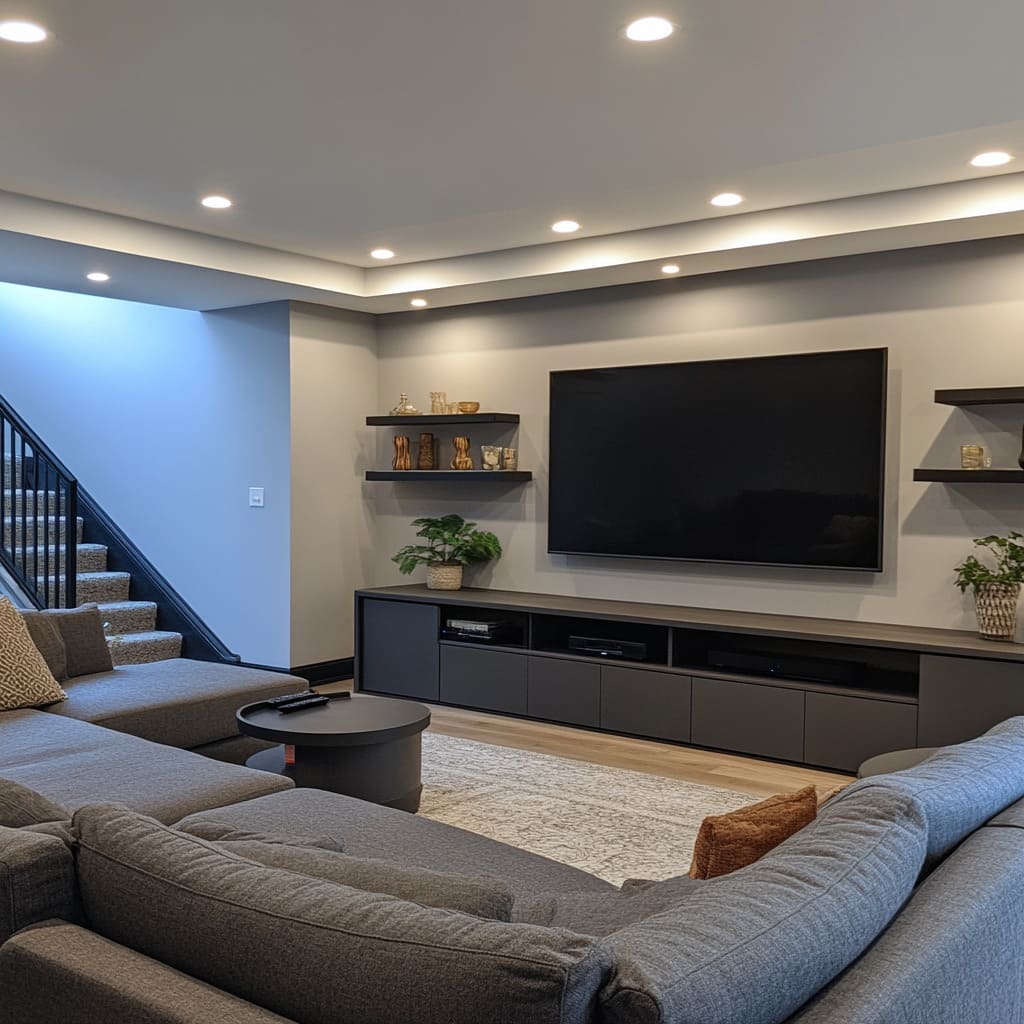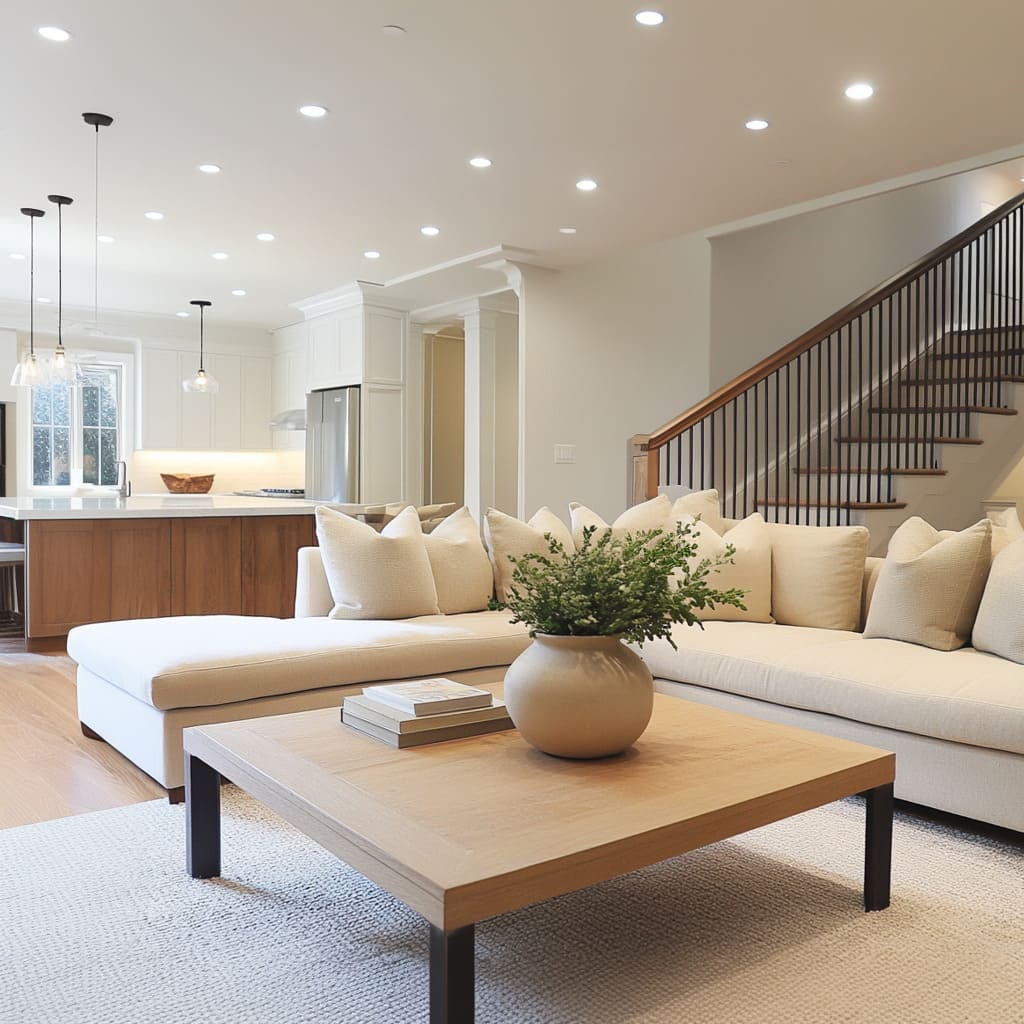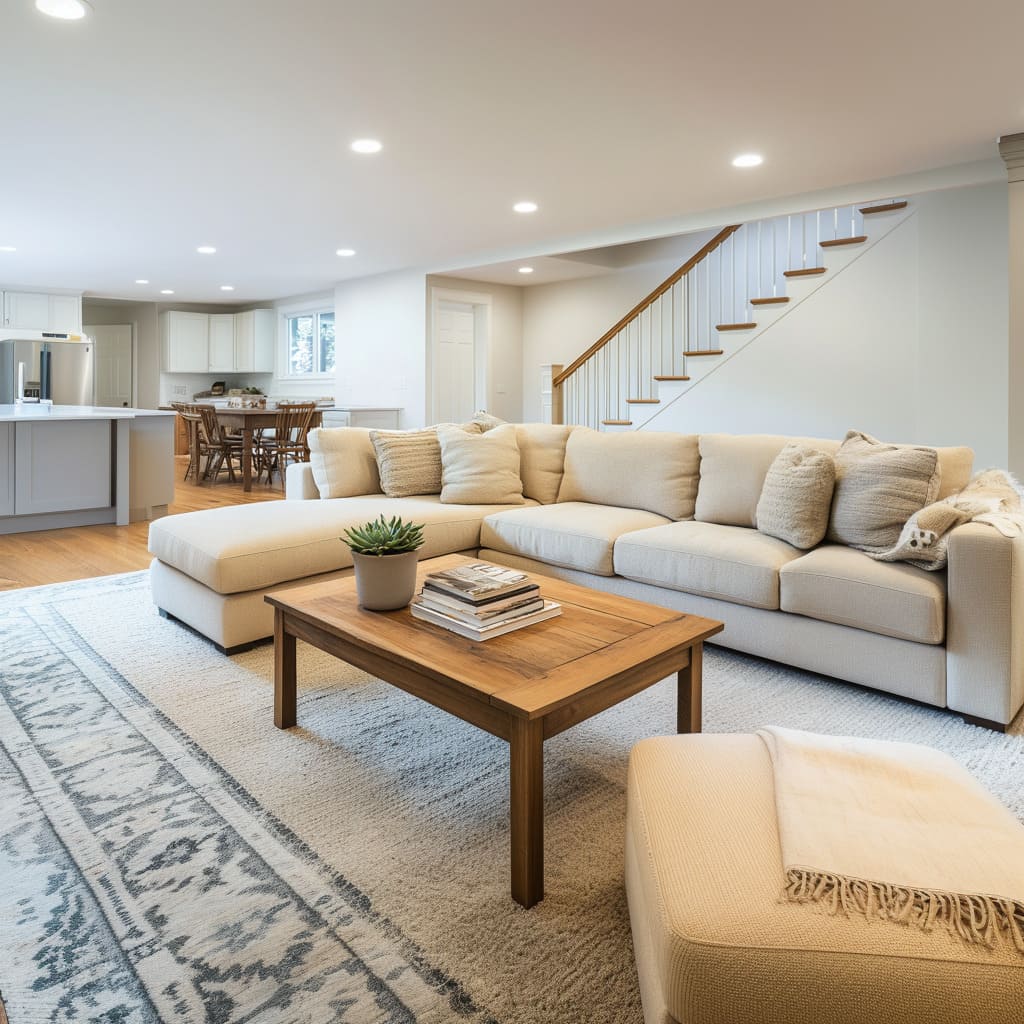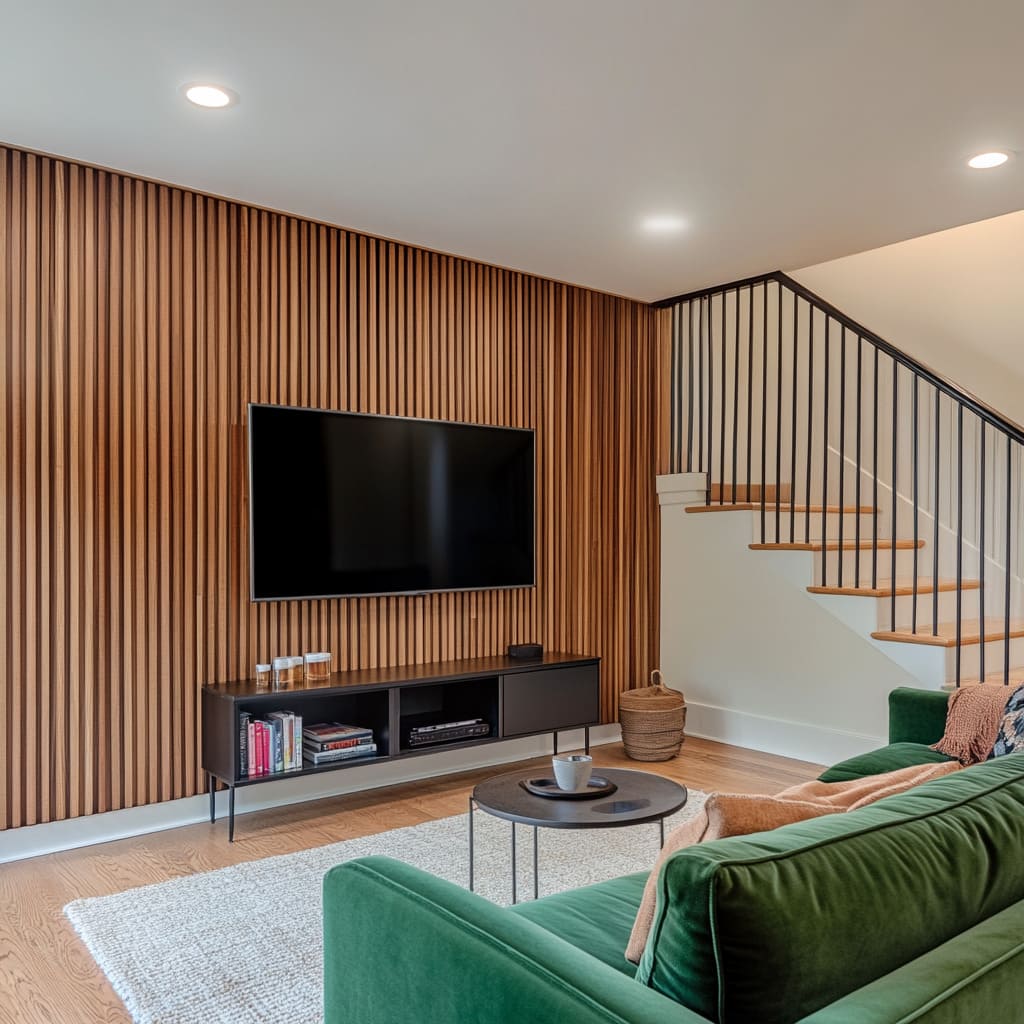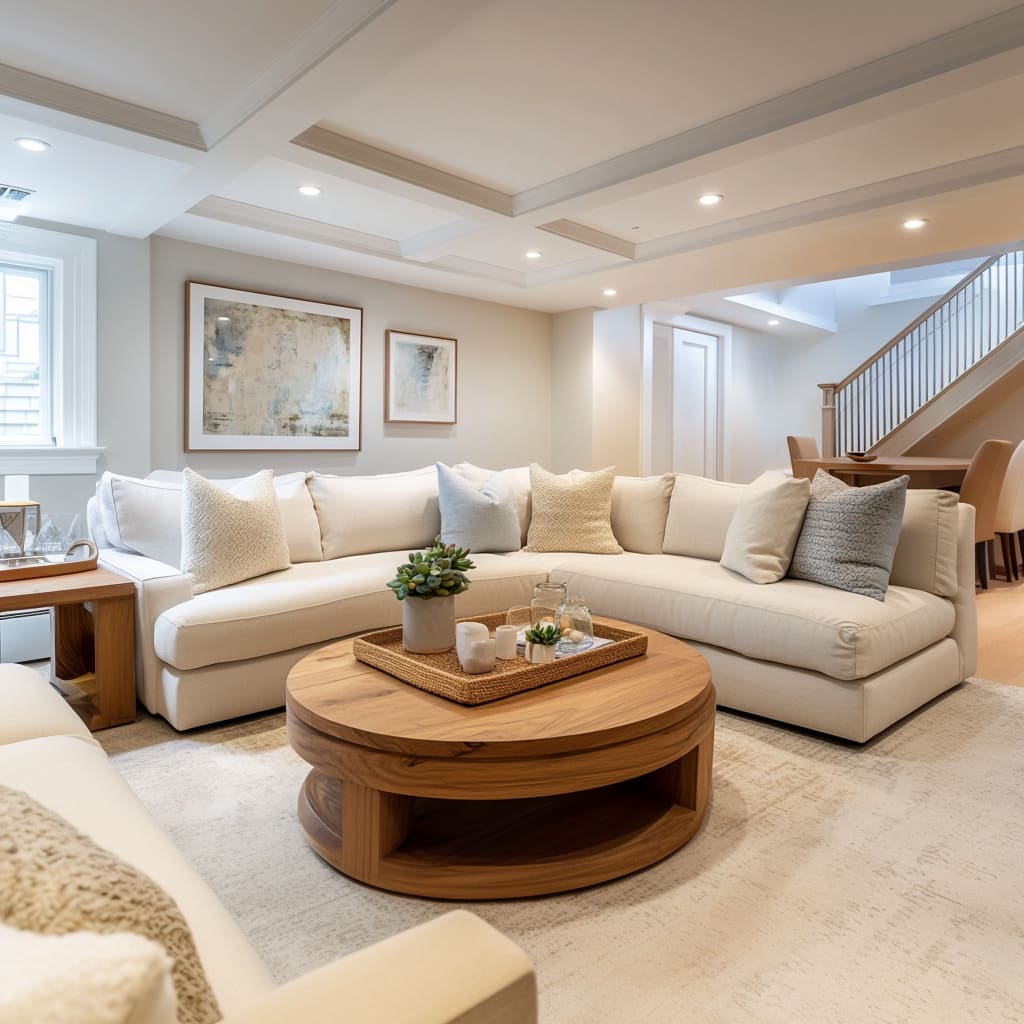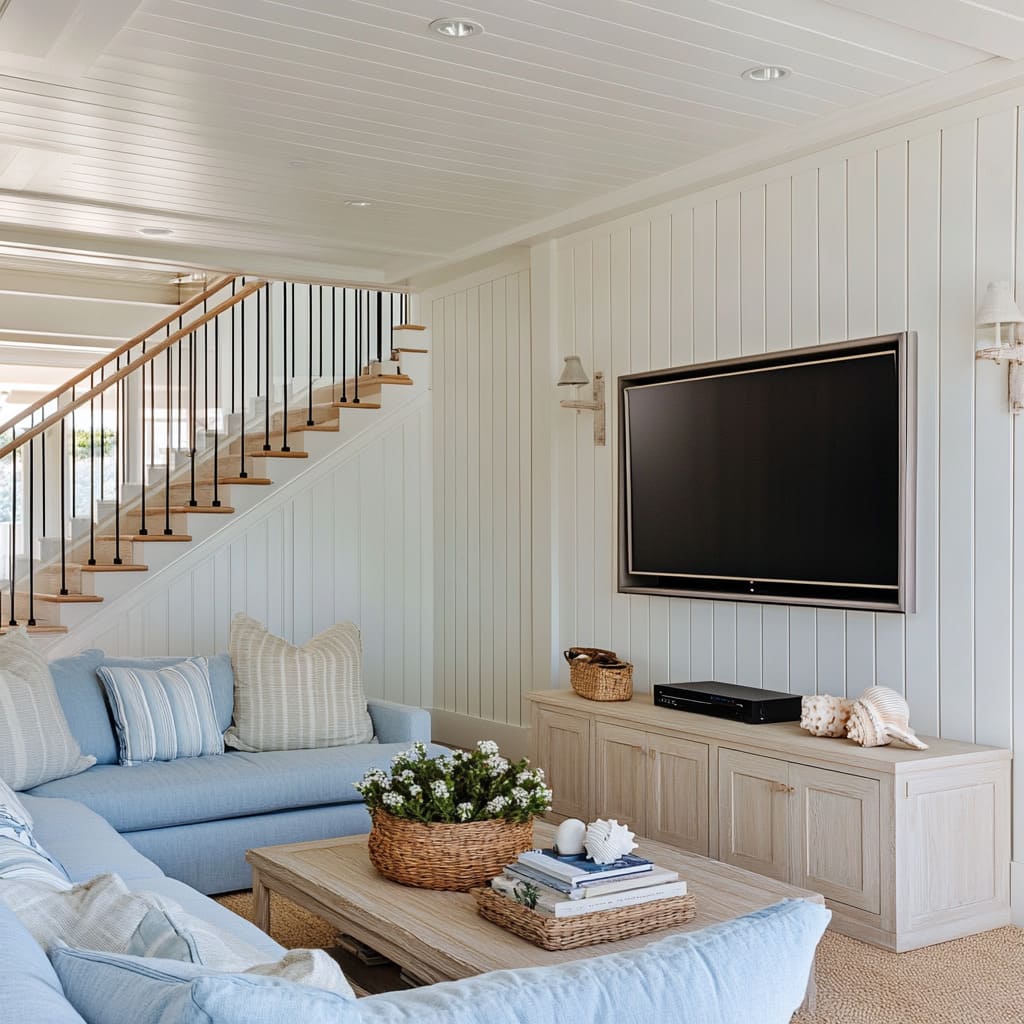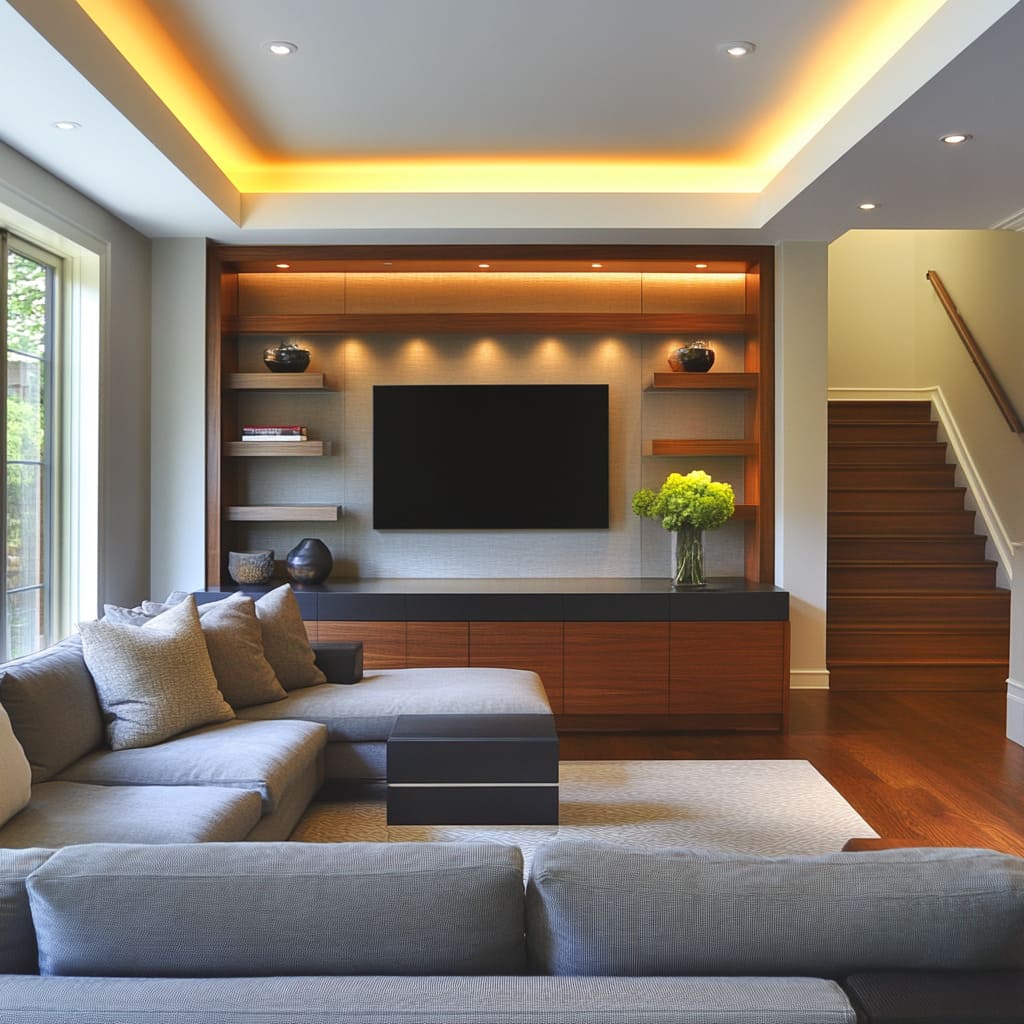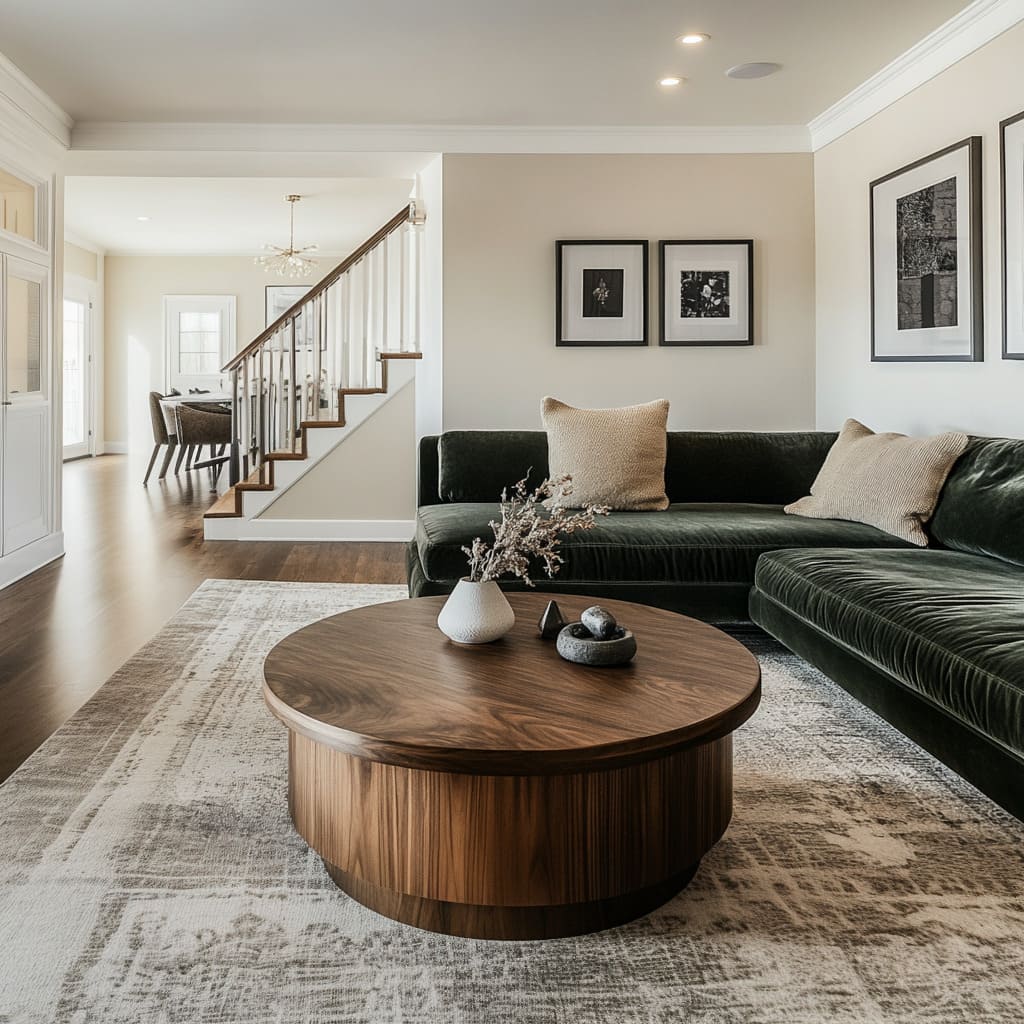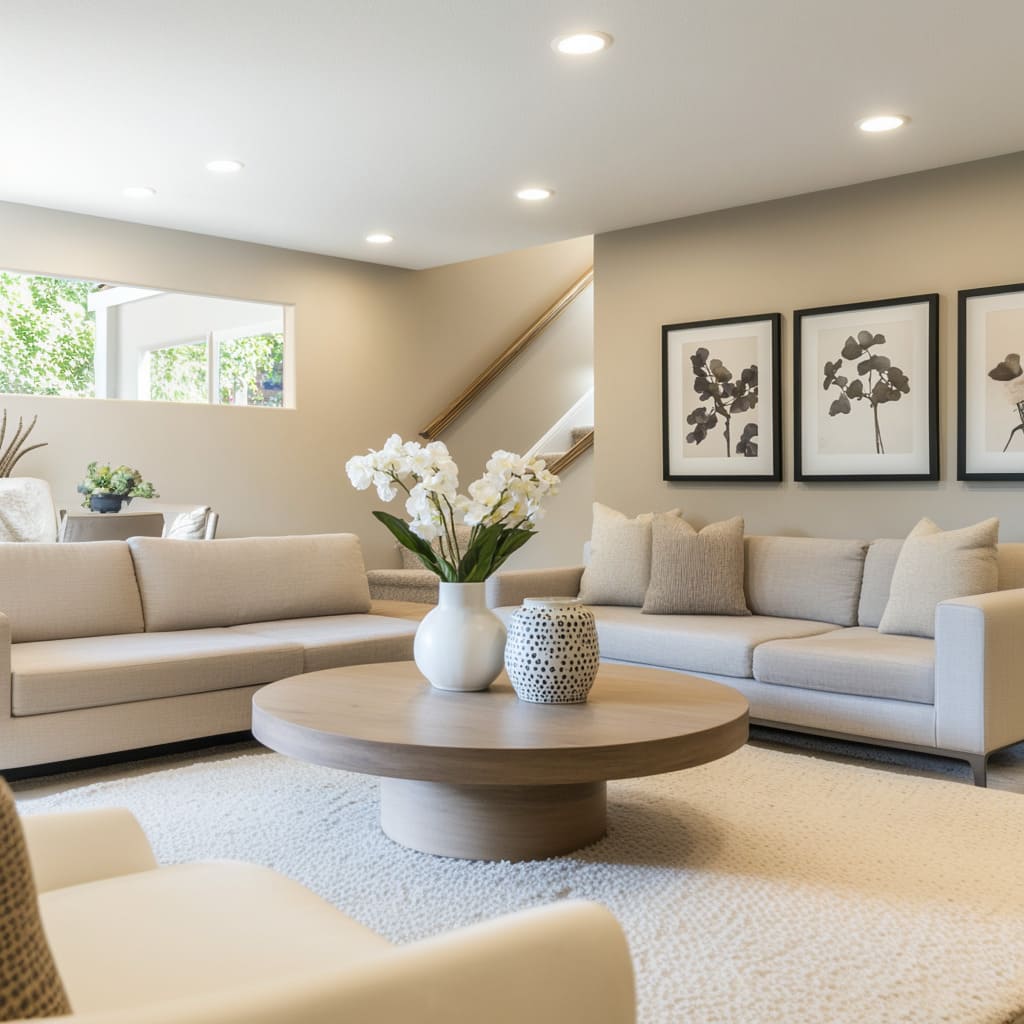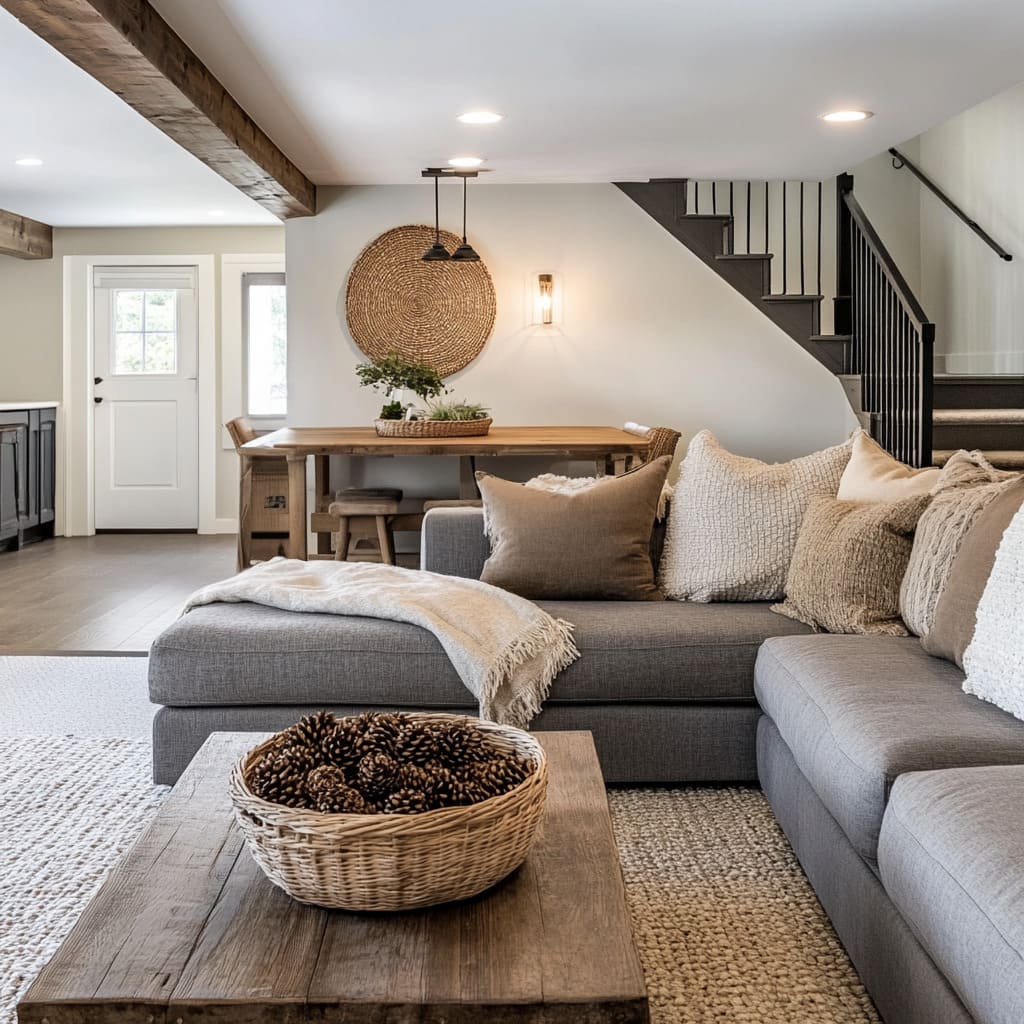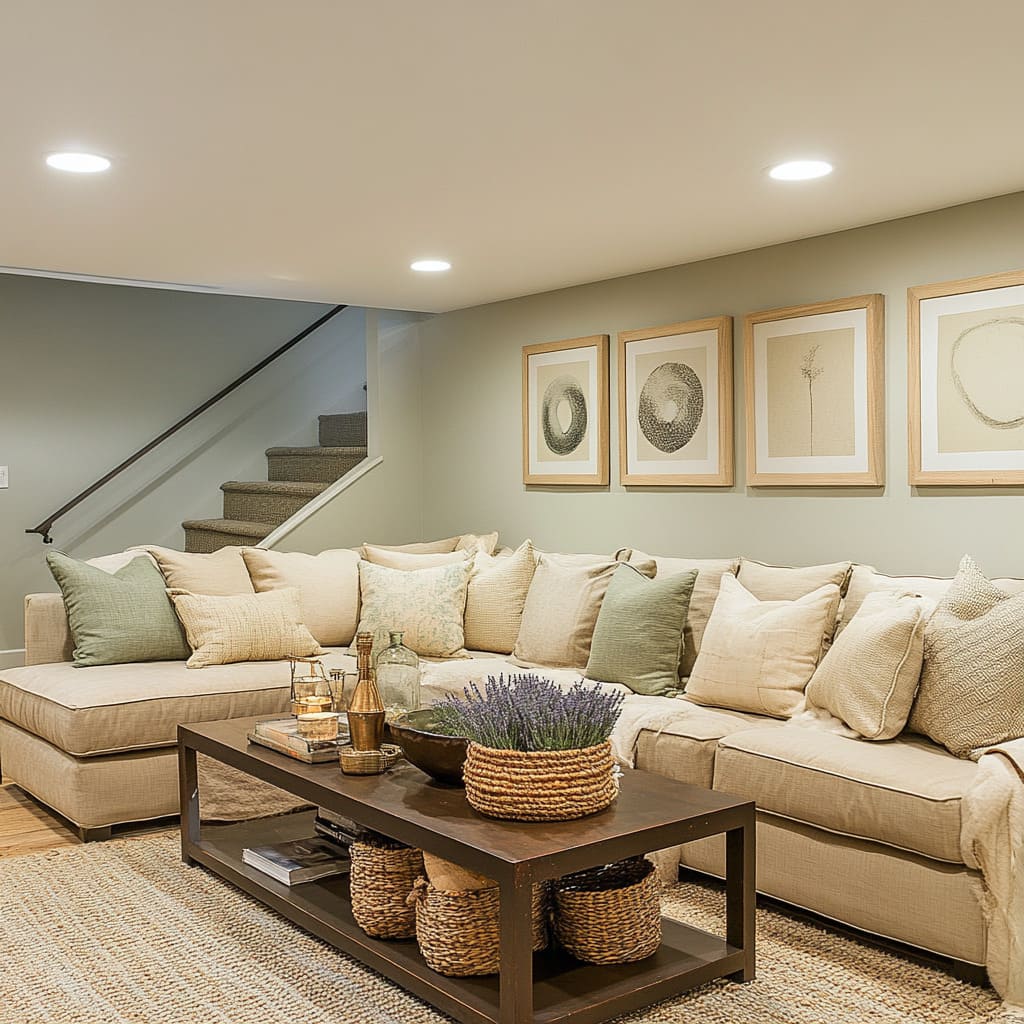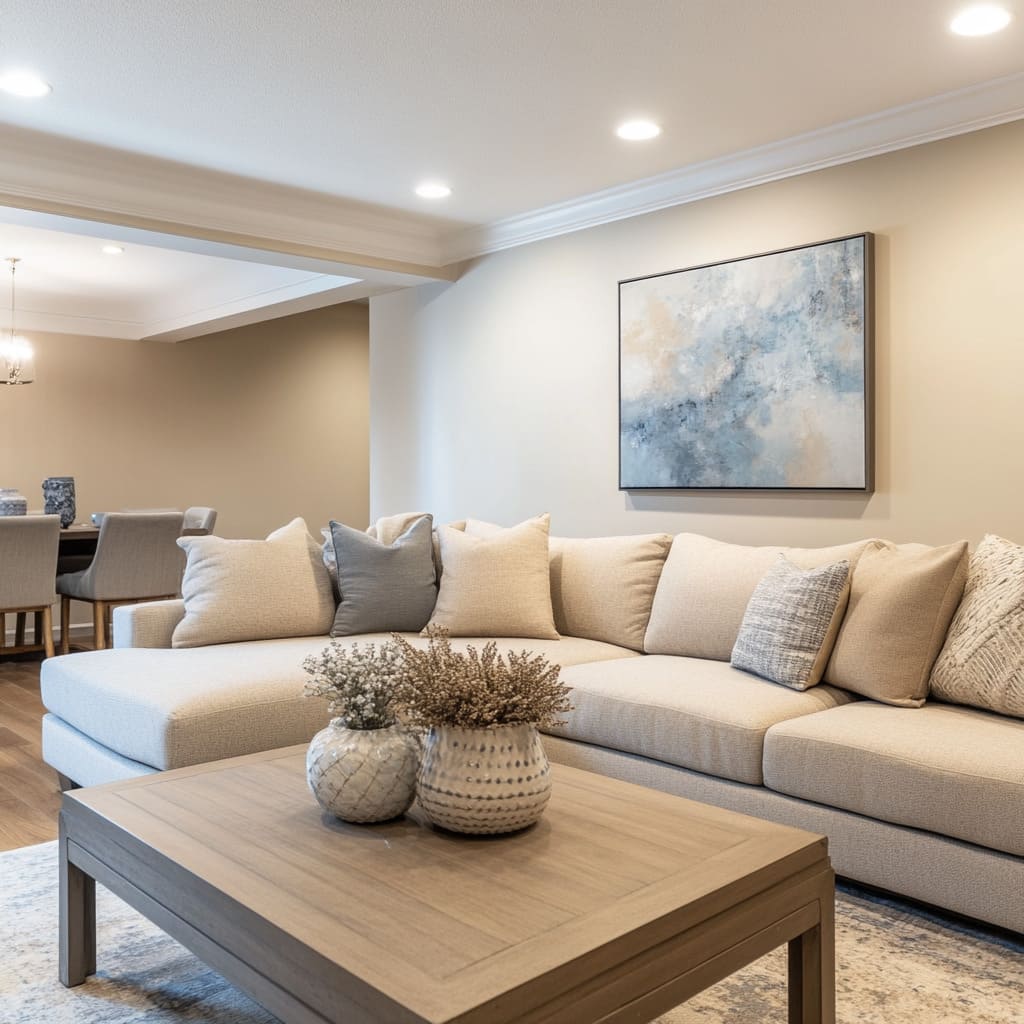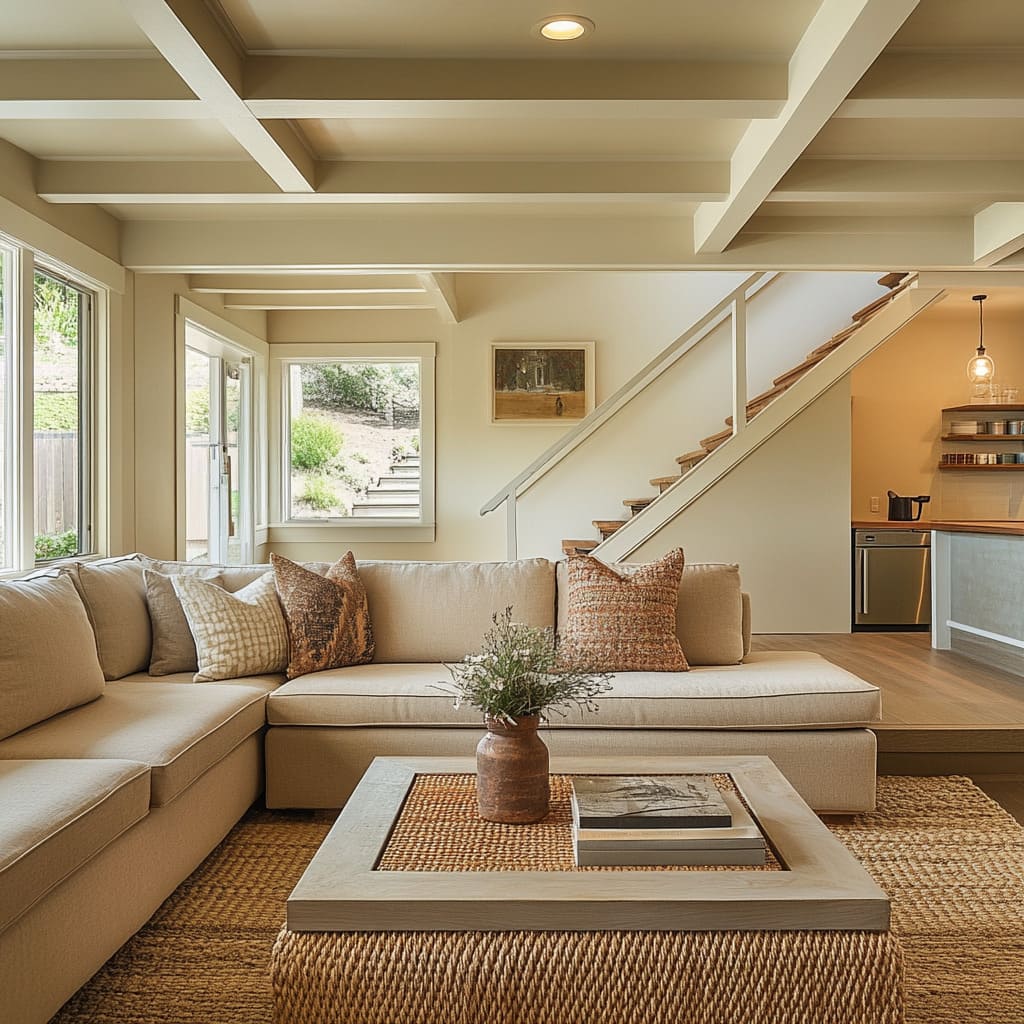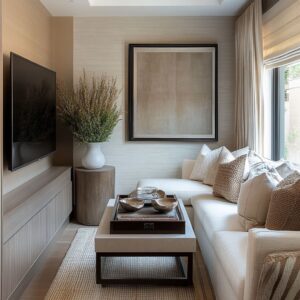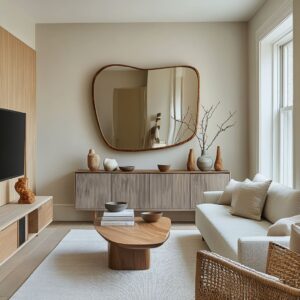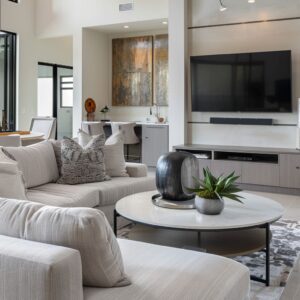Split-level homes, known for their multi-tiered layout, offer an interesting architectural style that divides living spaces across multiple levels. These homes became popular in the mid-20th century, offering a functional and open floor plan that makes excellent use of smaller plots of land.
Typically, a split-level home has staggered floors connected by short flights of stairs, dividing areas like the living room, kitchen, and bedrooms into distinct yet connected spaces. While this design maximizes square footage, one common issue faced in split-level homes is low ceilings, especially in living rooms located on lower levels
Addressing the challenge of a low ceiling in split level living rooms is essential for both practical reasons and to improve the overall aesthetic. Without the right approach, low ceilings can make a room feel cramped or restrictive.
However, with the correct design strategies, these rooms can be transformed into spaces that feel bright, open, and inviting. This article offers low ceiling living room ideas to help homeowners overcome the height limitations in their homes.
We will draw from real-life examples of thoughtful design choices that incorporate smart wall treatments, lighting, and furniture placement to give the illusion of height while maintaining a cozy atmosphere
Maximizing Vertical Space with Smart Wall Treatments
The Impact of Vertical Lines and Accent Walls
When working with low ceilings, one of the most effective strategies is to use vertical elements to draw the eye upward. By incorporating materials and designs that emphasize height, you can create the illusion of a taller ceiling.
One powerful example of this is seen in the living room, where a wood-slatted accent wall adds both texture and height to the space. The vertical slats create a natural line that guides the viewer’s eye upwards, subtly making the ceiling appear higher than it actually is
Wood slats are not only a stylish design choice but also a practical one for split level living rooms, where the architectural layout benefits from vertical design elements. A wall treatment like this adds depth and interest, turning a potential flaw—such as a low ceiling—into a design feature.
In addition to wood, other materials such as paneling or textured wallpaper can serve a similar function. The key is to choose vertical designs that contrast slightly with the wall color to make the effect more noticeable
These types of accent walls don’t just serve to alter the perception of height; they can also function as a focal point in the room. By directing attention to the accent wall, the low ceiling becomes less of a defining feature, while the overall room feels more cohesive and well-balanced.
The vertical lines create an inviting sense of flow, making it an ideal solution for homeowners looking for furniture arrangement split level living room ideas that balance style and functionality
Using Wallpaper to Enhance Room Height
Another great option for creating the illusion of height in a low-ceiling room is wallpaper—especially when used with vertical stripes. This clever design trick plays with perspective, encouraging the eye to travel upward along the stripes and making the room feel more spacious than it actually is.
A bold choice of vertical blue-and-white striped wallpaper not only adds character but also creates a sense of height, despite the low ceiling
When selecting wallpaper for a low ceiling living room, it’s important to choose patterns and colors that enhance the room’s dimensions without overwhelming the space. Vertical stripes work exceptionally well, but subtle tones like light blues, grays, or soft neutrals are often ideal, as they reflect light and keep the space feeling airy.
Avoid darker colors or overly busy patterns, which can shrink the perceived height of the room and make it feel even more confined
In smaller spaces, wallpaper with vertical elements can work wonders for the overall ambiance, especially when paired with complementary decor. Keep the rest of the room simple and clean, allowing the wallpaper to be the standout feature.
In this way, the room maintains its style without feeling cluttered. The right choice of wallpaper can transform an otherwise tricky space into a well-designed area, ideal for lounging, entertaining, or spending time with family
Strategic Furniture Placement for Low-Ceiling Rooms
Low-Profile Furniture for Maximizing Space
When working with low-ceiling spaces, the right furniture selection can make all the difference in how open or cramped the room feels. Low-profile furniture, such as sofas, media consoles, and coffee tables, is one of the most effective ways to prevent the room from feeling overcrowded or compressed.
By choosing pieces that sit closer to the ground, you allow for more vertical breathing room, giving the illusion that the ceiling is higher than it actually is
In a living room, for example, the use of a minimalist media console and a low-slung sectional sofa creates a sense of openness. The furniture doesn’t overwhelm the space, but instead, it complements the room’s proportions.
The media console, with its sleek and understated design, blends into the background while offering functional storage without visually cutting off the wall or ceiling. This helps keep the room feeling uncluttered and spacious
By using lower furniture, you also maintain more sightlines across the space, which is essential for furniture layout for split level living room spaces. In these homes, it’s common for living rooms to be open to or visible from adjacent areas, such as the dining room or kitchen.
Low-profile pieces ensure that these spaces flow into one another, creating an open-plan effect even in smaller rooms with height constraints. Low-profile furniture also minimizes the visual impact of a low ceiling.
When furniture is too tall or bulky, it draws attention to the height of the room. Conversely, keeping the furniture lower ensures that the ceiling fades into the background, helping create a more expansive and relaxed feel throughout the room
Sectional Sofas as Practical Seating Solutions
One of the most versatile and practical choices for seating in compact split level living rooms is the L-shaped sectional sofa. These sofas are particularly well-suited to low-ceiling rooms, as they maximize seating without taking up excessive space.
Additionally, they fit seamlessly into corners, leaving the central area of the room more open
Another example: the tufted sectional sofa anchors the room while offering ample seating for family and guests. Its L-shape allows it to hug the walls, making the most of the available square footage while maintaining a sense of openness in the middle of the room.
The plush cushions and deep seating also emphasize comfort, turning the living room into a cozy retreat
To elevate the overall look, sectional sofas can be paired with coordinating throw pillows and textured blankets. Opting for neutral-colored sectionals allows for greater flexibility with these accessories, offering an easy way to add color, pattern, or texture without overwhelming the space.
The key is balance: choose pillows that complement the sofa’s tone and add warmth without making the seating area feel too busy. This approach not only enhances the room’s comfort but also brings in layers that contribute to the overall aesthetic
Sectional sofas also work well when decorating a split level living room, as they help define the seating area in an open-plan layout. Whether the living room shares space with the kitchen or a dining area, a sectional can create a clear yet subtle boundary without needing additional dividers or furniture that might shrink the room visually
Lighting Solutions to Brighten Low-Ceiling Rooms
The Role of Recessed Lighting
Lighting plays a pivotal role in making low-ceiling rooms feel larger and more open. One of the best lighting solutions for this kind of space is recessed lighting.
Unlike pendant or chandelier lights that hang down and occupy precious vertical space, recessed lights sit flush with the ceiling, providing ample illumination without lowering the visual height of the room
Recessed lighting creates a clean, unobtrusive lighting source. The soft, even light they emit ensures the entire room is well-lit, which is crucial in smaller rooms that can easily feel dim or confined.
A key benefit of recessed lighting is that it offers even coverage, eliminating shadows that could make a room feel smaller or more enclosed
When installing recessed lights in a low-ceiling room, it’s important to consider spacing and placement. For a more expansive feel, position the lights around the perimeter of the room rather than directly in the center.
This will create a sense of openness and draw attention to the outer edges of the space, making the ceiling appear higher and the room larger overall
Creative Use of Ambient Lighting
Beyond recessed lighting, ambient lighting techniques can also help create a sense of height and warmth in low-ceiling living rooms. One creative approach is using LED perimeter lighting, which adds soft, diffused light along the ceiling edges.
This technique not only provides additional light but also subtly enhances the architectural features of the room
For instance, the use of soft LED lights in combination with recessed lighting creates an inviting glow. This lighting method works particularly well in rooms with coffered or recessed ceilings, as it highlights these architectural details while keeping the space well-lit.
For those considering living room ideas for split level homes, ambient lighting is a flexible option that can be customized to suit any space. From installing concealed lighting within ceiling moldings to incorporating table lamps and floor lamps that direct light upward, there are countless ways to use lighting to make a room feel taller and more welcoming
The key to successful ambient lighting in a low-ceiling space is ensuring that the light is warm and even, rather than harsh or too focused. By softening the lighting, you create a more relaxed atmosphere while still making the room feel bright and airy.
Pairing ambient lighting with natural light from windows or reflective surfaces like mirrors can further enhance the sense of space in the room
Color Palettes that Expand the Space
Neutral and Light Color Schemes
A well-chosen color palette has a profound impact on how a room feels, especially in a living room with low ceiling. One of the best ways to expand the sense of space in such a room is by using neutral and light tones on the walls, ceilings, and furniture.
These colors have the power to reflect light, making a room feel brighter and larger. White, soft gray, and beige are particularly effective for achieving this illusion, as they bounce both natural and artificial light around the room, helping to avoid the boxed-in feeling that low ceilings can sometimes create
For example, light beige and cream-colored walls give the space a more open feel. By using such hues on the ceiling and walls, you can diminish the visibility of the ceiling’s low height.
This creates a smooth transition between surfaces, which makes the room feel cohesive and seamless
When selecting neutral tones, it’s important to choose shades that complement the natural light available in the room. A room with large windows, for instance, benefits from softer, cooler tones like pale grays or white, which work hand in hand with natural light to amplify the sense of openness.
Alternatively, rooms with less natural light may need warmer neutrals like beige or light taupe to avoid feeling too cold
Combining these colors with natural materials such as wood, linen, and wool further enhances the feeling of airiness while keeping the room grounded and inviting. In decorating a split level living room, where multiple levels are visible and interconnected, maintaining a neutral palette across spaces helps unify the home, making each area feel more spacious and interconnected
Bold Accent Colors for Depth
While neutral tones are key to creating an open and expansive feel, a splash of bold color can add necessary depth and personality to the room. The trick is to strike a balance between a calming, neutral backdrop and strategically placed bold accents that do not overwhelm the space
A great example of this is the deep emerald green sectional sofa featured in one of the living rooms here. The bold color of the sofa creates a striking focal point without taking over the room.
By keeping the walls and other major surfaces neutral, the deep green becomes a design feature that adds warmth and richness to the space. This type of bold color helps define certain areas in the room without compromising the sense of space
If you’re not ready for a bold piece of furniture, smaller accent items, such as throw pillows, blankets, or even a feature wall in a rich wood tone, can have a similar effect. The key to incorporating these bold hues is to ensure they are well-distributed throughout the room and balanced by light or neutral elements.
This method keeps the room from feeling heavy and ensures the furniture layout for split level living room spaces remains cohesive and uncluttered
Clever Use of Natural Light and Windows
Maximizing Natural Light
Natural light is one of the most effective tools for making a low-ceiling room feel larger and more open. Large windows, whether multipanel or floor-to-ceiling, can flood a room with sunlight, instantly giving it a more airy and spacious feel.
The living room exemplifies this idea well, as the expansive windows invite an abundance of natural light, which brightens the entire space
When working with living room ideas for split level homes, maximizing natural light should be a top priority. Opt for window treatments that allow light to flow in freely.
Lightweight fabrics, such as linen or sheer curtains, are perfect for filtering light without obstructing the view or making the room feel enclosed. Avoid heavy, dark drapery, as it can make the room feel smaller and block the natural light that you want to take advantage of
In addition to maximizing light, large windows also create a visual connection to the outside, which further opens up the space. Even in rooms where the ceiling is low, a large window can make the room feel as if it extends beyond its four walls.
By drawing attention to the natural light and outdoor views, you shift focus away from the low ceiling, creating a more pleasant and visually expansive living space
Using Reflective Surfaces and Light Colors
Another way to enhance natural light in a living room with low ceiling is by incorporating reflective surfaces and light-colored decor. These elements work together to bounce light around the room, amplifying the brightness and making the space feel larger.
For instance, a light-colored rug or a white-painted ceiling can reflect natural light and give the impression of a taller room
For example: light-colored rugs in these spaces help diffuse natural light across the floor, adding brightness and visual space. When paired with light-colored walls and ceilings, the room feels more expansive.
Mirrors, too, can serve as a great addition, reflecting light and providing depth. Strategically placing a mirror opposite a window can create the illusion of a second light source, doubling the amount of light in the room
For an added layer of sophistication, consider reflective furniture or decor elements like a marble coffee table or glass vases. The polished surface of marble catches and reflects light, while glass decor can act as a subtle light diffuser, making the room feel brighter and more open.
Reflective pieces like these are excellent for living room ideas for split level homes, where every opportunity to create more openness and light should be embraced
Incorporating Texture for Depth and Warmth
Textured Walls and Accent Features
Adding texture to a split level home living room can significantly enhance the room’s depth and warmth without making the space feel smaller. Texture draws attention to the materiality of a room, creating visual interest while still allowing the space to feel inviting and comfortable.
When working with a small split level living room, where ceilings may be lower and space limited, it’s essential to incorporate texture thoughtfully
One effective way to introduce texture is through accent walls. As an example, vertical wood slats are used to craft a textured accent wall that doesn’t overwhelm the room.
The thin, vertical lines naturally guide the eye upward, which is ideal for a room with low ceilings, as it makes the space feel more elevated. Wood slats also bring warmth and an organic feel, contrasting nicely with smoother surfaces like a media console or sectional sofa.
This type of woodwork adds character while complementing a more minimalist aesthetic
Another way to introduce texture is through soft furnishings like tufted sofas. The living room showcases a plush, tufted sectional that adds dimension to the seating area.
The deep tufts create subtle shadows and patterns, providing a luxurious feel while remaining practical for everyday use. When paired with throws or decorative pillows, a tufted sofa becomes a focal point that enhances the room’s coziness
Layering texture in a low ceiling ideas for living room setting can also be achieved through various materials. Throws in knitted or woven patterns, upholstered ottomans, and fabric chairs can add depth.
For example, a chunky knit throw on a sleek sofa offers a tactile contrast, while a woven basket introduces natural texture, further warming up the space. The key is balance: mix smooth materials like leather or linen with more textured items like wool or velvet to avoid overwhelming the room
Rugs as Anchors in Open Spaces
Rugs play an important role in defining seating areas in open-plan layouts, especially in small split level living room ideas where multiple functions—such as lounging, dining, or TV watching—need clear delineation. In spaces where rooms flow into one another, a well-chosen rug can act as an anchor that grounds the furniture and adds comfort underfoot.
The living rooms could demonstrate how large neutral rugs can pull a seating arrangement together. These rugs offer visual separation without the need for physical barriers, keeping the room open yet organized.
Neutral tones, especially in natural fibers like wool or jute, help create a cohesive backdrop that doesn’t dominate the space
When selecting a rug for a low ceiling or small room, opt for one that extends slightly beyond the perimeter of the furniture, such as under the legs of a sofa or coffee table. This draws the eye outward, making the room feel larger than it is.
Textured rugs, such as those made from wool or other natural fibers, also bring warmth to hardwood or tiled floors, adding a welcoming and tactile layer to the room
Optimizing Storage in Compact Split-Level Living Rooms
Built-In Shelving and Media Units
Storage solutions are essential in maintaining a clutter-free look, especially in compact split level home living room layouts. Built-in shelving and media units provide both storage and style, ensuring that the room remains functional while also looking polished
Sleek, low-profile media consoles were used to maximize storage without taking up unnecessary space. These consoles provide ample room for storing books, electronics, or decorative items while keeping the aesthetic clean and modern.
The low height of the console also ensures that it doesn’t dominate the space, which is key in rooms with low ceilings. These built-ins make the most of horizontal space, allowing you to keep the floor plan open and free-flowing
Custom-built shelving that fits into alcoves or runs the length of a wall is another excellent way to optimize storage in split level rooms. Open shelving provides a place to display decorative elements, such as vases, artwork, or small plants, giving the room personality without crowding it.
The key to making these storage units work is to avoid overloading them; a well-curated display that leaves breathing room between objects will make the room feel more spacious
For homes with more limited space, consider storage options like media consoles with hidden compartments or furniture that doubles as storage, such as coffee tables with built-in drawers. Keeping surfaces clean and organized allows the room to feel lighter and more open
Using Vertical Space for Storage
When working with a small split level living room, it’s crucial to take advantage of vertical storage solutions. Floating shelves, tall bookcases, or built-in cabinetry that extends upward helps make the most of limited square footage while also directing the eye upward—key for rooms with lower ceilings
Built-in shelving units take advantage of vertical space by offering storage that doesn’t encroach on the floor plan. These units create storage for books and decorative items while remaining subtle and functional.
Tall bookcases are another great option, especially when placed against walls that connect different levels of the home, drawing attention to the architectural flow of the space
For smaller rooms, consider modular storage systems that can be arranged to fit awkward corners or tight spaces. Floating shelves, in particular, work well in rooms where floor space is limited.
They can be placed above seating areas or along walls that would otherwise remain unused, keeping clutter off the ground and maintaining a more open layout
To further optimize storage, integrate baskets, bins, or decorative boxes into your shelving system. Woven baskets add texture while hiding items that might otherwise clutter shelves.
These vertical storage solutions are key to creating a low ceiling ideas for living room design that is not only aesthetically pleasing but also highly functional
Cohesive Design Elements for Split-Level Rooms
Creating Flow Between Levels
One of the key design challenges in a split level living room design is creating a sense of continuity between the various levels of the home. Open staircases and consistent flooring choices are effective ways to maintain this flow, ensuring that the distinct areas feel connected rather than segmented.
When a room transitions from one level to the next, a seamless flow between the spaces is essential to make the overall design cohesive
There are living rooms as prime examples of this approach. Both feature open staircases with clean lines that lead from one level to the next without interrupting the visual flow of the room.
These staircases act as subtle connectors between different sections of the home, allowing the eye to move freely from one space to another. In addition, the open structure of the stairs allows light to pass through, preventing the staircase from feeling like a barrier or a heavy architectural element
The choice of flooring also plays a significant role in tying the levels together. Opting for a consistent flooring material, whether it’s hardwood, tile, or another surface, creates unity between spaces, making the transition between levels feel more fluid.
By continuing the same flooring from the living room through the stairs and into adjacent rooms, you reinforce the visual connection between the areas, which is particularly effective in tri level living room designs
When choosing a color palette for the flooring, it’s important to consider tones that complement both the furniture and the walls. Neutral colors like light wood or gray-tinted tiles often work well, as they provide a subtle backdrop that enhances the overall flow without drawing too much attention to themselves.
For homes with different functions on each level, maintaining a consistent floor design ensures that the whole space feels cohesive and harmonious
Keeping Decor Minimal Yet Personal
While flow and consistency are important, personalizing the space with meaningful decor adds character and warmth. However, in low ceiling living room design ideas, there is a fine balance to strike: too much decor can easily clutter the space, making it feel smaller and more cramped.
Therefore, keeping the decor minimal yet thoughtful is essential for maintaining an airy, open atmosphere
Simple but personal decorative elements—such as framed photos, small potted plants, and carefully selected artwork—add a touch of personality without overwhelming the space. These small accents bring a lived-in feel to the room while maintaining the clean lines and minimalism that are crucial in homes with lower ceilings
To create a similar effect in your own space, focus on curating a few meaningful pieces rather than filling the room with multiple decorative items. For example, a well-placed vase of fresh flowers on a coffee table, a couple of framed prints on the wall, or a single statement sculpture on a bookshelf can all make the room feel personalized without creating clutter.
Choosing decor that adds texture or subtle pops of color, like soft throws or cushions, can also enhance the overall warmth of the room
It’s important to strike a balance between aesthetics and functionality. Too many purely decorative items can make a space feel visually overwhelming, especially in rooms with lower ceilings.
Instead, aim for decor that serves a purpose, such as stylish storage baskets or functional lamps that also double as design accents. Keeping things simple ensures that the room remains open and inviting, while still reflecting your personality and style
Conclusion
Designing a split-level living room, particularly one with low ceilings, comes with its own set of challenges. However, as we’ve explored throughout this article, these limitations can inspire creativity.
From maximizing vertical space with smart wall treatments and choosing low-profile furniture to incorporating light, cohesive flooring, and personal yet minimal decor, there are plenty of practical solutions for enhancing the space
Split level living room design ideas that focus on balance, flow, and thoughtful use of light and texture can transform any low-ceiling room into a bright, functional, and stylish area. With the right approach, even the most compact or multi-level spaces can feel expansive and inviting, proving that design limitations often lead to the most creative and impactful results

